PIONEER POS SOLUTION DASH Tablet PC User Manual
PIONEER POS SOLUTION INC Tablet PC
Contents
- 1. User manual
- 2. User's manual
User manual
D
DA
AS
SH
H
U
Us
se
er
r
G
Gu
ui
id
de
e
V
Ve
er
rs
si
io
on
n:
:
1
1.
.0
0
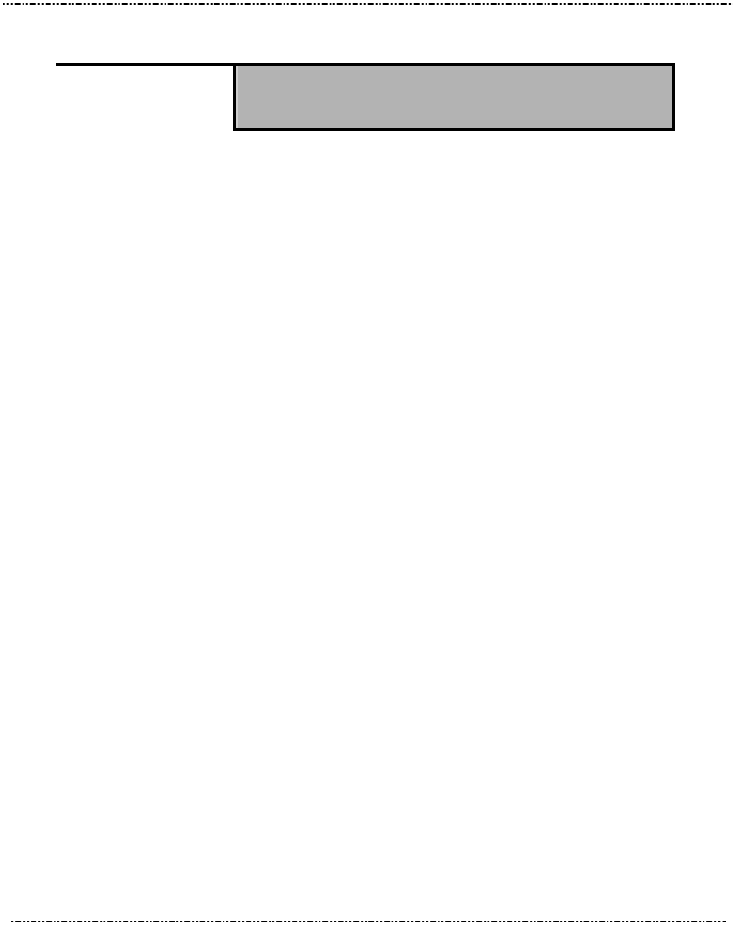
DASH User Guide
2
Introduction
1. Please read these safety instructions carefully.
2. Please keep this User’s Manual for later reference.
3. Please disconnect this equipment from connecter before cleaning.
Don’t use liquid or prayed detergent for cleaning. User moisture
sheet or cloth for cleaning.
4. Make sure the equipments are connected to the power source with
the correct voltage, frequency, and ampere.
5. All cautions and warnings on the equipment should be noted.
6. Never pour any liquid into opening: this could cause fire or
electrical shock.
7. Never open the equipment. For safety reason, the equipment
should only be opened by qualified service personnel.
8. If one of the following situations arises, get the equipment
checked by a service personnel:
a. Liquid has penetrated into the equipment.
b. The equipment has been exposed to moisture.
c. The equipment has not worked well or you cannot get it work
according to user manual.
d. The equipment has dropped and damaged. If the equipment
has obvious sign of breakage.

DASH
User Guide
3
9. Caution on use of battery: User the battery recommended by the
manufacturer or the same type of battery installed by the
manufacturer. If incorrect battery is used, it may cause explosion
or fire hazard. Recycle or discard used batteries according the
manufacturer’s instruction or your local authority.
10. The computers use nonvolatile memory that requires a battery to
retain system information when power is removed. The 3V lithium
battery is on the system board. The battery life depends on the
amount of time the computer is powered on. If the computer does
not display the correct time and date, replace the battery.
IMPORTANT:Loss of BIOS settings occurs when the battery is
removed. BIOS settings must be reconfigured whenever the battery
is replaced.
WARNING:A risk of fire and chemical burn exists if the battery is not
handled properly. Do not disassemble, crush, puncture, or short
external contacts, or expose the battery to temperatures higher than
60 °C (140 °F). Do not dispose of a used battery in water or fire.
CAUTION:Danger of explosion if battery is incorrectly replaced.
Replace only with same or equivalent type recommended by the
manufacturer. Discard used batteries according to the
manufacturer’s instructions.

DASH User Guide
4
FCC Compliance Statement
This equipment has been tested and found to comply with the limits
for a class B digital device, pursuant to part 15 of the FCC Rules.
These limits are designed to provide reasonable protection against
harmful interference in a residential installation.
This equipment generates uses and can radiate radio frequency
energy and, if not installed and used in accordance with the
instructions, may cause harmful interference to radio
communications. However, there is no guarantee that interference
will not occur in a particular installation. If this equipment does cause
harmful interference to radio or television reception, which can be
determined by turning the equipment off and on, the user is
encouraged to try to correct the interference by one or more of the
following measures:
-- Reorient or relocate the receiving antenna.
-- Increase the separation between the equipment and receiver.
-- Connect the equipment into an outlet on a circuit different from
that to which the receiver is connected.
-- Consult the dealer or an experienced radio/TV technician for
help.
FCC Caution: Any changes or modifications not expressly approved
by the party responsible for compliance could void the user's authority
to operate this equipment.

DASH
User Guide
5
FCC RF Radiation Exposure Statement:
1. This Transmitter has been demonstrated co-location compliance
requirements with Wi-Fi, Bluetooth and RF ID. This transmitter
must not be co-located or operating in conjunction with any other
antenna or transmitter.
2. This equipment complies with FCC RF radiation exposure limits set
forth for an uncontrolled environment. This device was tested for
typical hand held operations with the device contacted directly to
the human body to the back side of the tablet pc. To maintain
compliance with FCC RF exposure compliance requirements, avoid
direct contact to the transmitting antenna during transmitting.
E
Eu
ur
ro
op
pe
e
–
–
E
EU
U
D
De
ec
cl
la
ar
ra
at
ti
io
on
n
o
of
f
C
Co
on
nf
fo
or
rm
mi
it
ty
y
This device complies with the essential requirements of the R&TTE
Directive 1999/5/EC and EMC directive 2004/108/EC. The following
test methods have been applied in order to prove presumption of
conformity with the essential requirements of the R&TTE Directive
1999/5/EC and EMC directive 2004/108/EC:
EN 55022: 2006 +A1: 2007
EN 61000-3-2 : 2006
EN 61000-3-3 : 1995 + A1 : 2001 + A2 : 2005
EN 55024: 1998 + A1: 2001 + A2: 2003

DASH User Guide
6
(IEC 61000-4-2: 2008;
IEC 61000-4-3: 2006 + A1:2007;
IEC 61000-4-4: 2004;
IEC 61000-4-5: 2005;
IEC 61000-4-6: 2003 + A1: 2004 +A2: 2006;
IEC 61000-4-8: 1993 +A1: 2000;
IEC 61000-4-11: 2004)
EN 60950-1: 2001
Safety of information technology equipment
EN 300 328 V1.7.1: 2006
EN 301 489-17 V2.1.1: 2009 and EN 301 489-1 V1.8.1: 2008
EN 62311: 2008
This device is a 2.4GHz wideband transmission system (transceiver),
intended for use in all EU member states and EFTA countries under
the following conditions and/or with the following restrictions:
In Italy the end-user should apply for a license at the national
spectrum authorities in order to obtain authorization to use the
device for setting up outdoor radio links and/or for supplying
public access to telecommunications and/or network services.
This device may not be used for setting up outdoor radio links in France
and in some areas the RF output power may be limited to 10 mW EIRP in
the frequency range of 2454 – 2483.5 MHz. For detailed information the
end-user should contact the national spectrum authority in France.

DASH
User Guide
7
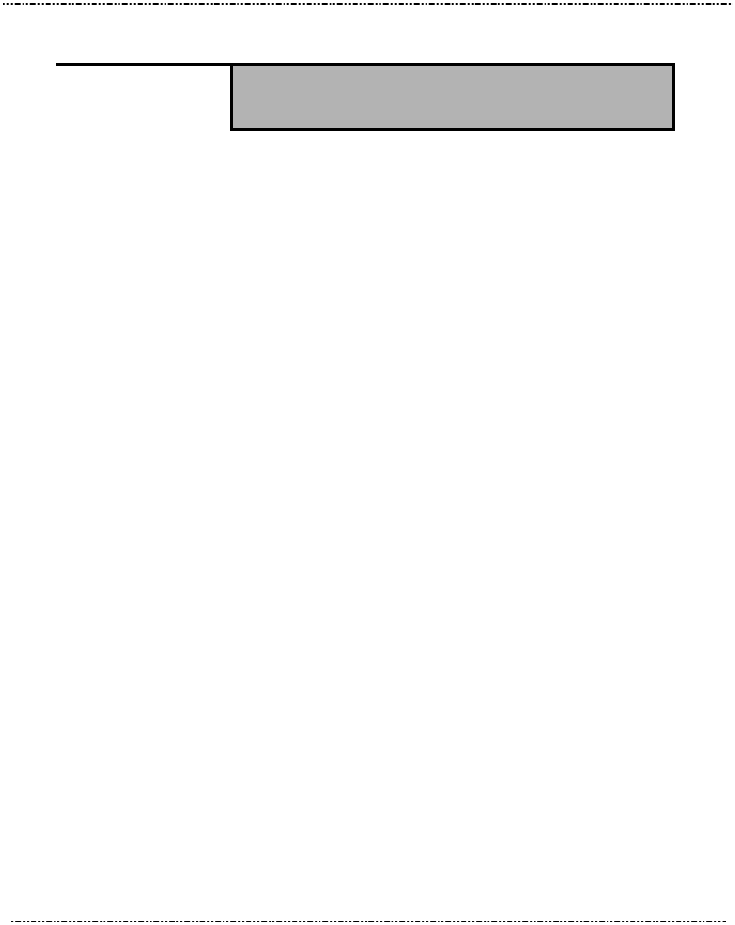
DASH User Guide
8
Table of Contents
Introduction ...........................................................2
Chapter 1 General Information...........................13
1.1. Introduction ........................................................................................13
1.2. Specification.......................................................................................13
1.2.1. Main System................................................................................................13
1.2.2. I/O Interface .................................................................................................15
1.2.3. In Front Control............................................................................................16
1.2.4. Power Management.....................................................................................16
1.2.5. Environment.................................................................................................16
1.2.6. Material........................................................................................................17
1.2.7. Operation OS...............................................................................................18
1.2.8. Certifications ................................................................................................18
1.2.9. Optional: External Accessories ..................................................................118
1.2.10. Optional: Packing Lists ..............................................................................18
1.3. Packing List........................................................................................19

DASH
User Guide
9
1.4. Dimensions.........................................................................................19
Chapter 2 System Setup .....................................22
2.1. Exploring Your DASH ........................................................................22
2.1.1. ..................................................................The front side of the DASH
...............................................................................................................................22
2.1.2. .................................................................. The rear side of the DASH
...............................................................................................................................26
2.1.3. ..................................................................The right side of the DASH
...............................................................................................................................27
2.1.4. ....................................................................The left side of the DASH
...............................................................................................................................28
2.1.5. ...............................................................The bottom side of the DASH
...............................................................................................................................30
2.2. Preparing for Installation...................................................................30
2.2.1. ............................................................. Installing the Rubber Bumpers
...............................................................................................................................30
2.2.2. ............................................................Removing the Rubber Bumpers
...............................................................................................................................31
2.2.3. ...................................................................Plugging to the DC supply
...............................................................................................................................31

DASH User Guide
10
2.2.4. ..........................................................................Starting Your System
...............................................................................................................................33
2.2.5. .....................................................Connecting the keyboard and mouse
...............................................................................................................................34
2.3. Installing the Drivers..........................................................................35
Installing Windows 7 from Optical Disk Drive.........................................................35
Installing the Chipset Driver ...................................................................................35
Installing the VGA Device Driver............................................................................36
Installing the Audio Device Driver ..........................................................................37
Installing the Touch Panel Driver............................................................................37
Installing the LAN Device Driver ............................................................................38
Installing Hotkey Driver and Utility .........................................................................38
Installing Wireless LAN Device Driver....................................................................39
Installing the Bluetooth Driver And Utility ...............................................................40
Installing the Camera Utility ...................................................................................40
Chapter 3 Using the DASH .................................41
3.1. Introduction ........................................................................................41
3.2. Using the USB Ports..........................................................................42

DASH
User Guide
11
3.3. Using the External Audio System.....................................................43
3.4. Installing the Battery..........................................................................43
Chapter 4 The BIOS Setup Program..................45
4.1. Main Screen Setup Utility..................................................................46
4.2. Advanced BIOS Features ..................................................................48
4.3. Security Chip Configuration .............................................................50
4.4. Boot Management Setup...................................................................51
4.5. Exit Control.........................................................................................52
Chapter 5 User Interface for DASH....................54
5.1. Introduction ........................................................................................54
5.2. About the User Interface ...................................................................54
5.2.1 .......................................................Enable or disable the User Interface
...............................................................................................................................54
5.2.2 ......................................................................... Hibernate this System
...............................................................................................................................56
5.2.3 ....................................................................System Status Information
...............................................................................................................................56
5.3. Using the Application ........................................................................58
5.3.1 ..............................................................................Brightness Control

DASH User Guide
12
...............................................................................................................................59
5.3.2 ..................................................................................Volume Control
...............................................................................................................................60
5.3.3 ................................................................................Webcam Launch
...............................................................................................................................61
5.3.4 ...................................................................................Monitor Switch
...............................................................................................................................61
Chapter 6 Maintenance .......................................63
6.1. Maintaining the Battery .....................................................................63
6.2. Maintaining the LCD Display.............................................................64
6.3. Cleaning the DASH ............................................................................64
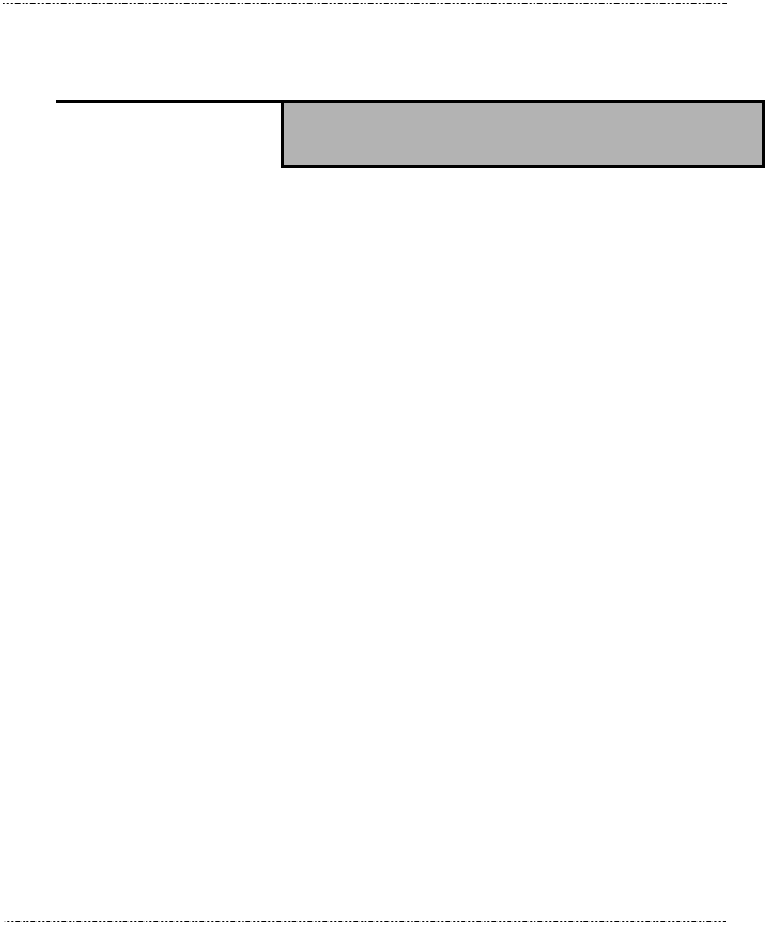
DASH
User Guide
13
C
Ch
ha
ap
pt
te
er
r
1
1
General Information
1
1.
.1
1.
.
I
In
nt
tr
ro
od
du
uc
ct
ti
io
on
n
DASH semi-rugged tablet PC is Intel® Oak Trail Atom Z670 1.5GHz
processor core architecture based Semi-rugged Tablet PC with a bright
10.1-inch LED backlight LCD display. The powerful CPU brings the most
dynamic applications to life without sacrifices to any industrial reliability.
Delivering a variety of connectivity features, built-in USBs, Microphone and
Headphone port. It is ideal for an all-around system performance.
Furthermore, DASH semi-rugged tablet PC is equipped with fanless design.
1
1.
.2
2.
.
S
Sp
pe
ec
ci
if
fi
ic
ca
at
ti
io
on
n
The DASH semi-rugged tablet PC is a flexible, multi-functional flat tablet PC.
With following specifications that can be applied in diverse operational
environments and implemented in multi-faceted applications.
1.2.1. Main System
Platform:
Intel® Oak Trail Platform
GPU :

DASH User Guide
14
Intel® Atom Z6701.5GHz
Processor packing : Micro-FCBGA
Cores : Single Core
On-die L2 Cache : 512KB
FSB Speed : 400MHz
Chipset:
Chipset : Intel® Whitney Point PCH (SM35)
BIOS :
Phoenix BIOS
Graphics :
Intel® HD Graphics with dynamic frequency, support MPEG2,
MEPG4, VC-1, WMV9 and H.264
System Memory :
DDR II 800 (32b) Memory Down, up to 2GB
Storage :
1 x 1.8-inch half-size micro-SATA Solid State Disk
LCD Screen :
Panel size : 10.1-inch LED Backlight LCD
Brightness : 200nits
Resolution : 1366 RGB(W) x 768(H) WXGA
Touch Panel :
5-wire Resistive Touch Panel
Sunlight Readable :
Transflective plus type
Audio :

DASH
User Guide
15
Internal Speaker : 2 x High Quality Speakers (2W)
Internal Microphone : 1 x in front Bezel
Communication :
1 x Wireless IEEE 802.11 b/g/n
1 x Bluetooth 2.1 + EDR
RFID (NFC) :
Frequency : 13.56MHz ±7KHz
Reading Range : within 40 ~50mm depending on type of tags
HF RFID Reader :
ISO/IEC 14443A/B, 15693
Mifare 1K/4K, Ultralight
NFC-IP1 Protocol
Webcam :
Front Bezel: 1.3 Mega-pixel Camera audio input (Digital
Microphone) functions.
Rear Bezel: 2 Mega-pixel Camera, LED auxiliary light.
1.2.2. I/O Interface
External I/O :
2 x USB 2.0 type A
1 x Headphone Jack
1 x Microphone Jack
1 x Docking Connector
1 x DC-Jack
LED Status Indicator:

DASH User Guide
16
Power LED Status: 1 x Green/Orange/Red Colors
Storage LED Status: 1 x Blue Color
Wi-Fi LED Status: 1 x Blue Color
1.2.3. In Front Control
Switch :
1 x Power Button
1 x Lock Button
1 x RF Button
Button :
Navigation Buttons : 5+ Way navigation button with integrated enter
button
Program Function Buttons : 5 x Function keys (Programmable)
Sensor :
1 x Light Sensor
1.2.4. Power Management
Power Adapter :
AC to DC, 19VDC@3.42A, 65W
AC 100V ~ 240V, 50~60Hz input
19 DC-in
Battery (Internal Battery) :
Internal Smart Lithium Polymer Battery, 3800mAh
1.2.5. Environment
Operation Temperature :

DASH
User Guide
17
0°C to +40°C (MIL-STD-810G Method 501.5 and 502.5)
Storage Temperature :
-20°C to +60°C (MIL-STD-810G Method 501.5 and 502.5)
Humidity :
5-90% without condensation (MIL-STD-810G Method 507.5)
Drop :
4-ft drop to Plywood (MIL-STD-810G Method 516.6 Procedure IV)
Vibration :
Operating : SSD (MIL-STD-810G Method 514.6 Category 4 Fig
514.6C-3)
Mechanical Shock :
Operating : 20g, 11ms, Terminal sawtooth
Non-operating : 40g, 11ms, Terminal sawtooth (MIL-STD- 810G
Method 516.6 Procedure I)
Water/Dust Resistance : IP54 equivalent
1.2.6. Material
Chassis :
Semi-Rugged Tablet PC Slate
Enclosure :
PC/ABS Plastic, PC/ABS and TPU Double Injection with Protective
Rubber Grips Set
Dimension (W x H x D mm) :
277.8 x 206 x 26.5mm
Weight :
Approximate 1.2kg (with internal battery)

DASH User Guide
18
1.2.7. Operation OS
Windows 7 Embedded and Windows 7 Pro. Embedded
1.2.8. Certifications
EMI :
CE (EN55022/EN55024), FCC (PART 15B)
Safety :
CE
RF :
CE (EN 300 328 / EN 301 489)
FCC (PART15C)
SAR :
FCC SAR (OET 65)
CE SAR (EN62311)
WCDMA/HSDPA 900/2100MHz
1.2.9. Optional: External Accessories
External Battery Kits :
External Battery Pack :
Hot-swappable Lithium Polymer battery pack - doubles
duration of mobile operation, 4000mAh
1.2.10. Optional: Packing Lists
Carrying Case
Handle Secures
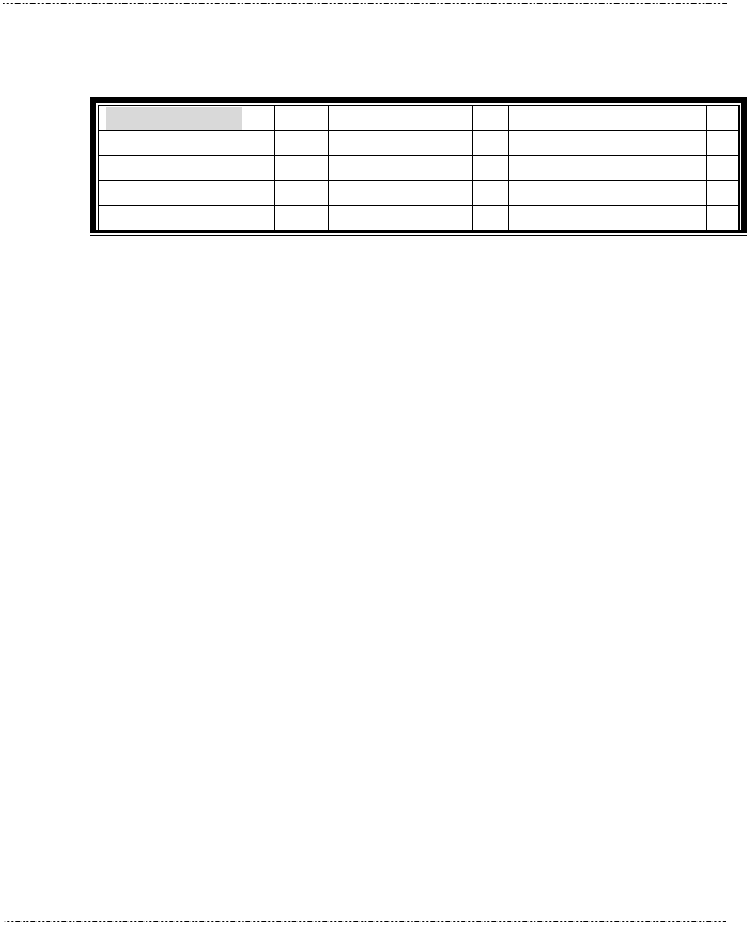
DASH
User Guide
19
1
1.
.3
3.
.
P
Pa
ac
ck
ki
in
ng
g
L
Li
is
st
t
MainPackingList QTY
Main system 1 Utilities CD 1 Quick Setup Guide 1
Power Adapter 1 Power Code 1 Corner Rubber Screw 4
Corner Rubber 4 Shoulder Strap 1 Hand Strap 1
Stylus 1 Hook Screw 6 Desiccant 1
1
1.
.4
4.
.
D
Di
im
me
en
ns
si
io
on
ns
s
The following sections provide information for the DASH dimensions.
Dimensions (units in mm)
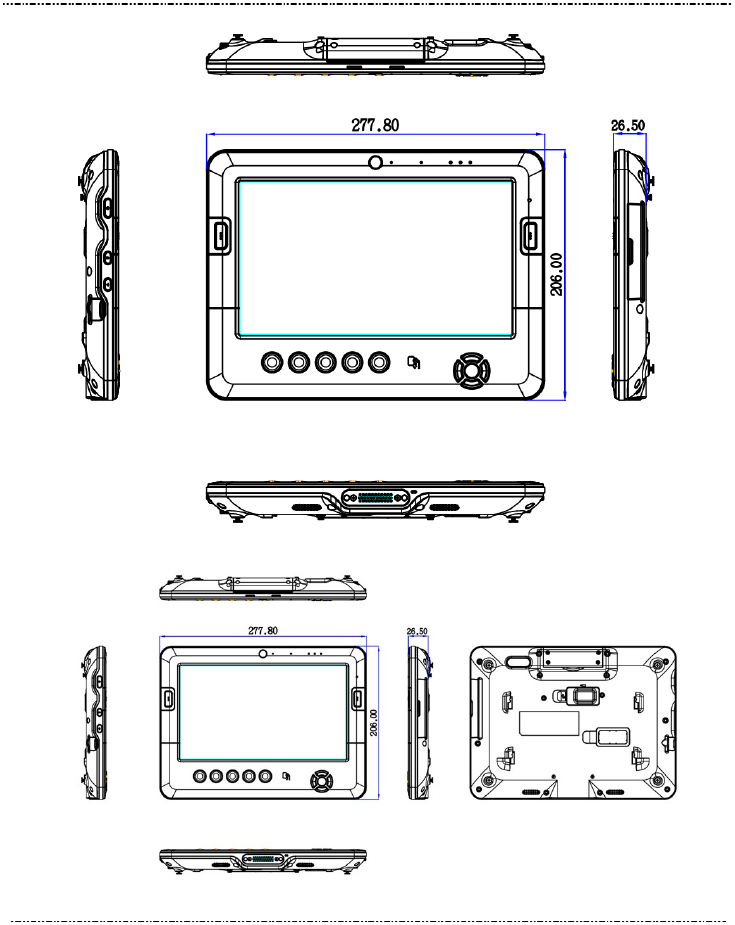
DASH User Guide
20
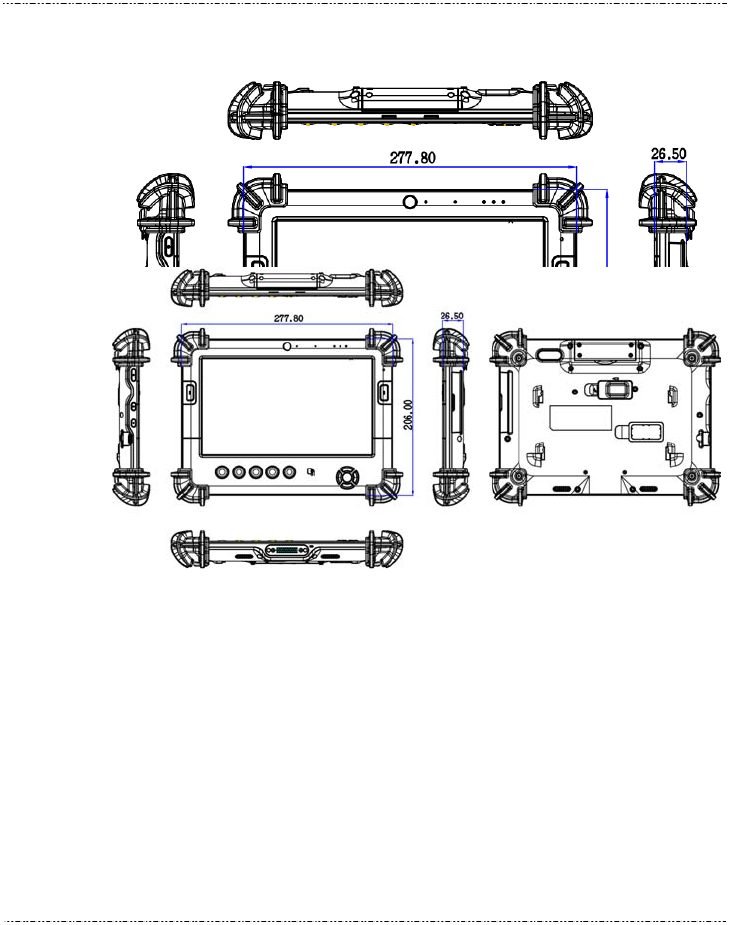
DASH
User Guide
21
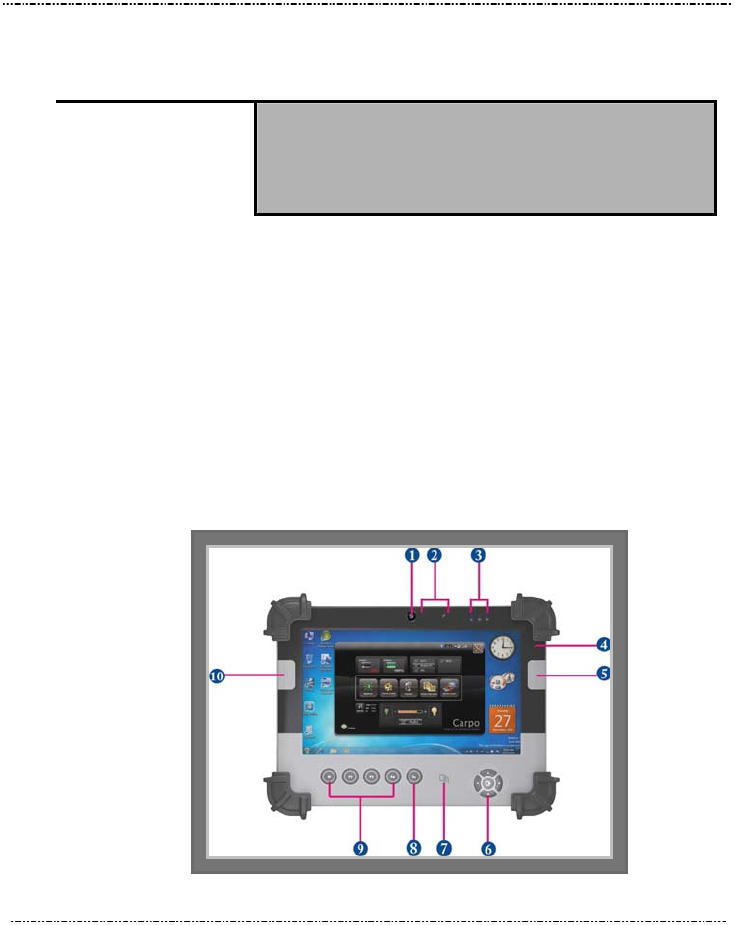
DASH User Guide
22
C
Ch
ha
ap
pt
te
er
r
2
2
System Setup
2
2.
.1
1.
.
E
Ex
xp
pl
lo
or
ri
in
ng
g
Y
Yo
ou
ur
r
D
DA
AS
SH
H
Before starting to set up the DASH, take familiar with the locations and
purposes of controls, drives, connectors and ports, which are illustrated in
the figures below. When placed upright on the desktop, the front panel of
the DASH appears as shown in Figure 2.1.
2.1.1. The front side of the DASH
The front side of the DASH is equipped the I/O as described below.
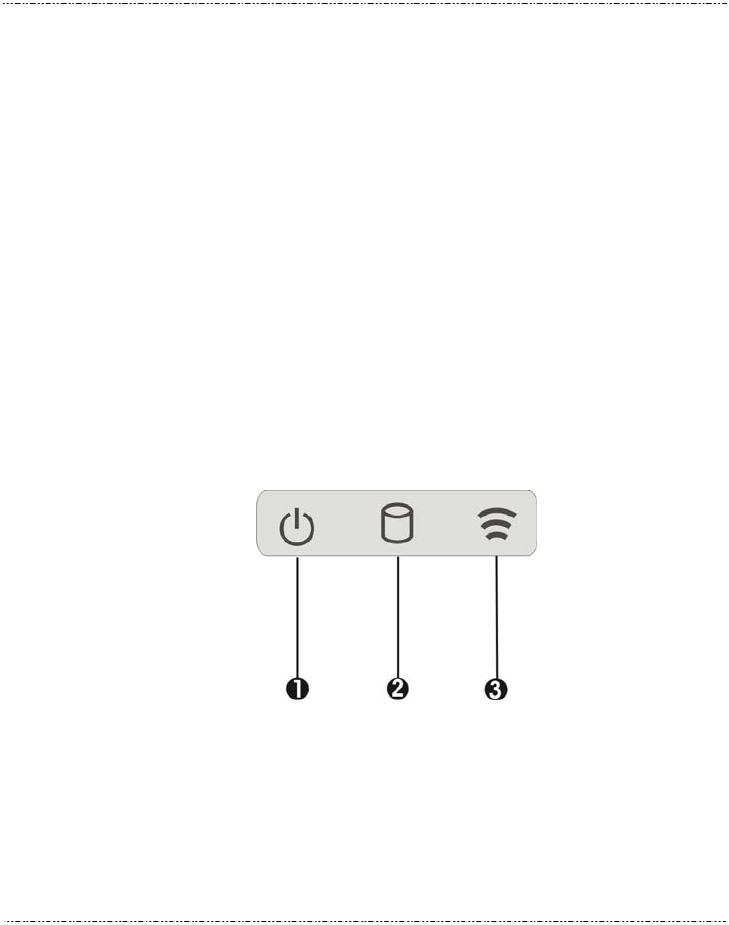
DASH
User Guide
23
1. Camera/1.3 Mega-pixel 2. Digital Microphone
3. LED Power/Storage/Wi-Fi 4. Light Sensor
5. Barcode Button 6. Navigation Buttons
7. RFID 8. User Interface Button
9. Program Function Buttons 10. Barcode Button
Camera/1.3 Mega-pixel
The built-in camera can be used as a communication device for
allowing you to capture images, record videos, and have video chats. It
is 1.3M pixels and transmitting instant image through network for
conference.
Digital Microphone
The built-in microphone receives sounds and voices when used with
the built-in camera.
LED Power/Storage/Wi-Fi
Keeps you informed of your system’s current power status, Storage
operating status, and Wi-Fi accessing status.
1. Power Indicator LED 2. Storage Access
3. WiFi/Bluetooth
Power Indicator LED
To let you know that system is turned on and indicate the
battery charging status.

DASH User Guide
24
Lights green when the system is powered on and battery
is fully charged.
Lights blinking green when the system is in S3 Suspend.
Lights orange indicates that the battery is in charging.
Lights off when the battery is discharged or power off.
Lights blinking red when the battery power is low under
10%.
Storage Access
When LED in blue light indicates that the system is accessing
the Storage Drive.
WiFi/Bluetooth
When LED turns on in blue light indicates that the
WiFi/Bluetooth is activated. When LED lights off, it indicates
that the function is disabled.
Light Sensor
This sensor works with brightness control. When you set the brightness
control to Auto (for details, please refer 5.3.1), it will automatically
detect the light environment, and adjust the screen brightness
according to the operating environment.
Navigation Buttons
The navigation buttons include up, down, right, and left arrow keys and
the Enter key in the center.
This function lets you press the arrow keys to move the cursor up, down,
right, or left on the screen, after that press Enter to execute the function.
RFID
Data/files transferring from the IR-equipped or equivalent device to your
DASH System. This port only can receive data or files from other
RFID-equipped or equivalent device.
User Interface Button

DASH
User Guide
25
If your system does not define User Interface function, this button can
be programmable to execute specific application. When you program
your application, please write this directory as listed below into your
source code, then the system will aware and execute this application.
F5_EXE="C:\WINDOWS\system32\taskmgr.exe"
F5_PARA=""
F5_PATH=""
Programmable Function Buttons
If your system does not define this button’s function, this button can be
programmable to execute specific application. When you program your
application, please write this directory as listed below into your source
code, then the system will aware and execute this application.
[Setup]
F1_EXE="c:\windows\explorer.exe"
F1_PARA=""
F1_PATH=""
F2_EXE="C:\Program Files\Windows Media Player\wmplayer.exe"
F2_PARA="/prefetch: 1"
F2_PATH=""
F3_EXE="c:\program files\E-Cam\E-CAM.exe"
F3_PARA=""
F3_PATH=""
F4_EXE="C:\WINDOWS\system32\osk.exe"
F4_PARA=""
F4_PATH=""
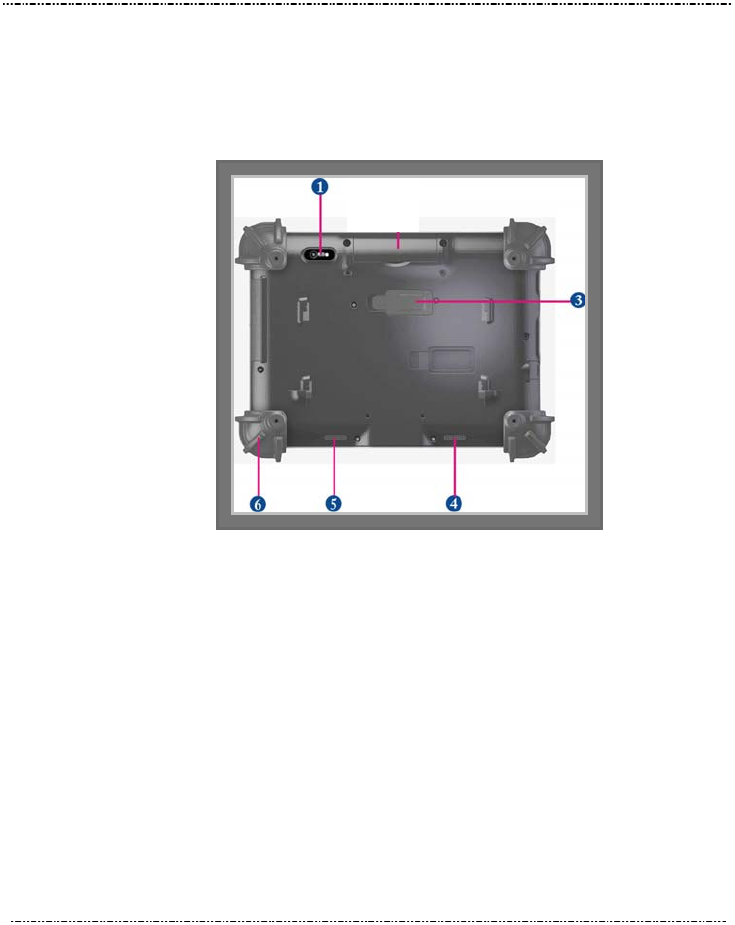
DASH User Guide
26
2.1.2. The rear side of the DASH
The rear side of the DASH is equipped the I/O as described below.
1. Camera/2 Mega-pixel
3. External Battery Connector
4. 5. Speaker 6. Protective Rubber
Camera/2 Mega-pixel
The built-in camera can be used as a communication device for
allowing you to capture images, record videos, and have video chats. It
is 2.0 M pixels and transmitting instant image through network for
conference.
External Battery Connector
To install the External Battery, please remove the cover of external
battery connector before snap the battery pack into the external battery
connector (For details, please refer 3.4).
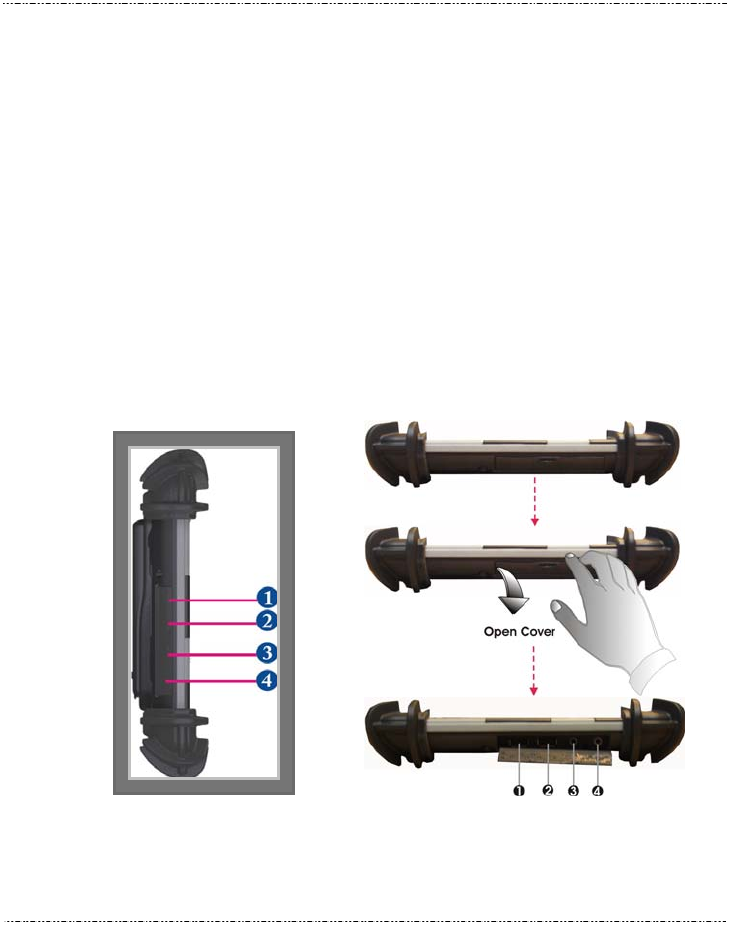
DASH
User Guide
27
Speaker
Integrated left and right mini stereo speakers for sound and audio
output for your multimedia presentations or listening pleasure.
Protective Rubber
To prevent system harm from vibration or shock, the system has been
designed with installing four protective rubber at the four corner.
2.1.3. The right side of the DASH
The right side of the DASH is equipped the I/O as described below.
1. Microphone port 2. Headphone port
3. USB port 4. USB port
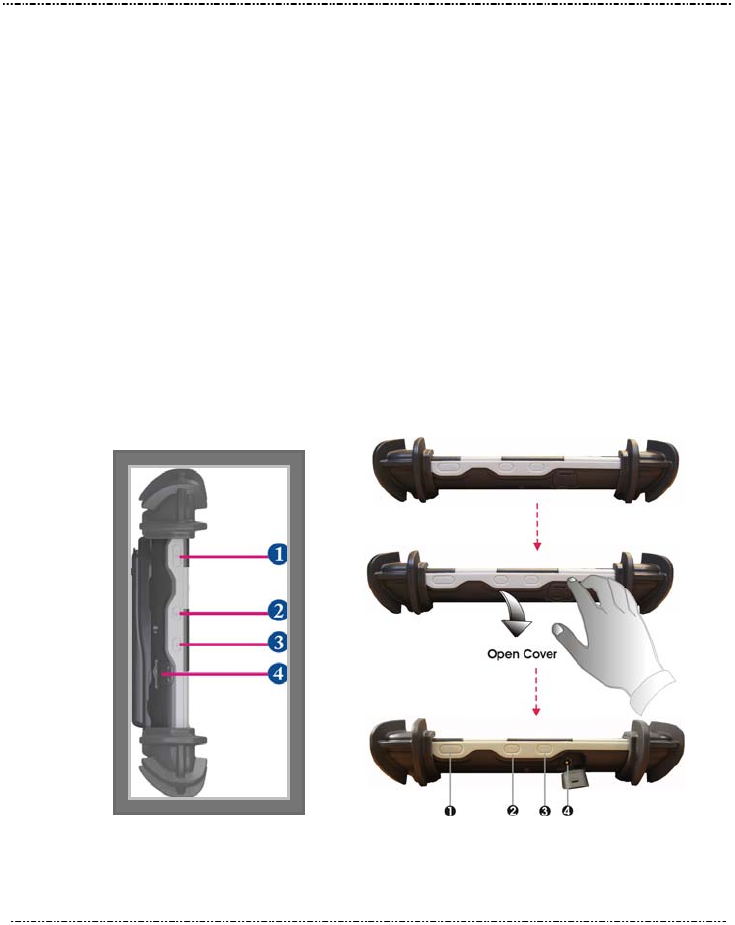
DASH User Guide
28
Microphone port
Allows you to connect an external microphone for monophonic sound
recording directly into your Tablet PC.
Headphone Port
Lets you plug in a stereo headphone, powered speakers, or earphone
set for personal listening.
USB Ports (x2)
The Universal Serial Bus (USB) port allows you to connect USB
2.0-compliant devices (for example, printers, scanners and so on) to
your Tablet PC.
2.1.4. The left side of the DASH
1. Power Button 2. Lock Button
3. Wi-Fi Button 4. DC-Jack
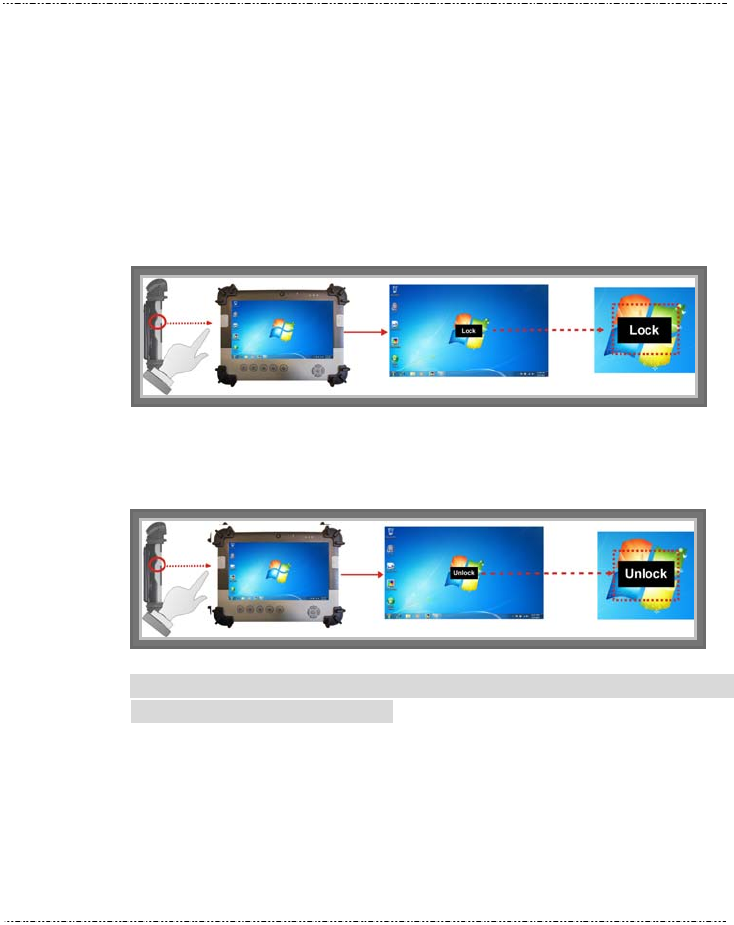
DASH
User Guide
29
Power Button
Switches the computer power on and off, or resumes whenever it is in
Suspend mode.
Lock Button
To prevent the screen or function keys have been touched by random,
you can press the Lock button to halt the system temporarily; the
screen will appear Lock message.
To make the system back to work, press the Lock button again to
disable the halt function, the screen will appear Unlock message.
Note: When you press the lock button, please hold for 3 seconds to
activate or close this function.
Wi-Fi Button
Press this button to activate or close the Wi-Fi, Bluetooth .
DC-Jack
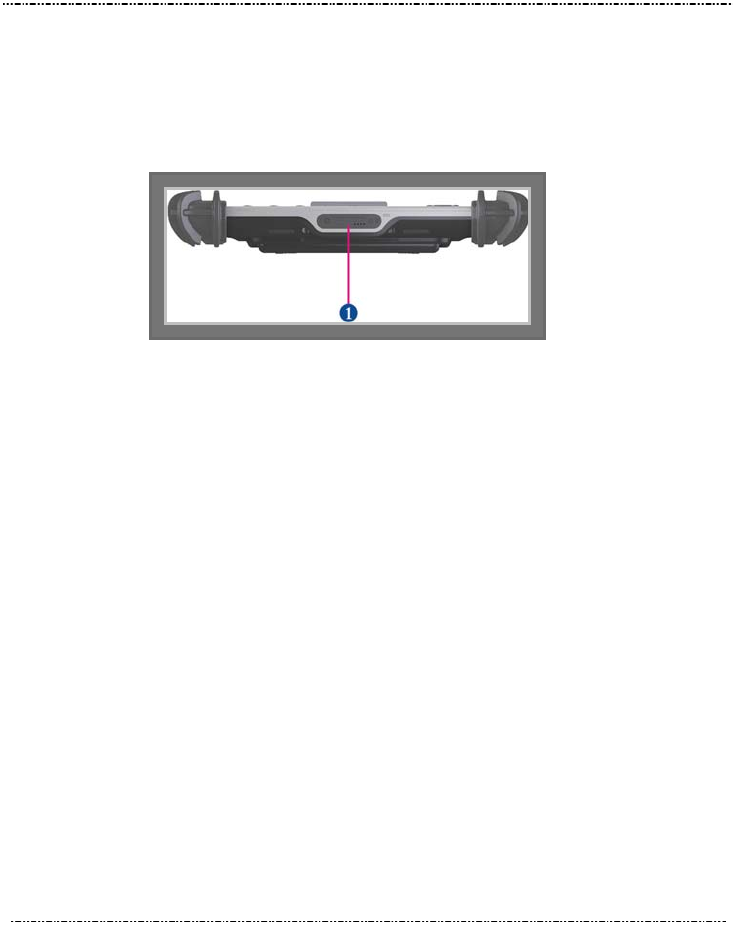
DASH User Guide
30
Lets you connect the AC power adapter in supplying continuous power
to your Tablet PC and recharging the battery.
2.1.5. The bottom side of the DASH
1. Docking Connector
Docking Connector
Lets you connect the system to docking stand to dock the tablet PC
when you are at home or office desk.
2
2.
.2
2.
.
P
Pr
re
ep
pa
ar
ri
in
ng
g
f
fo
or
r
I
In
ns
st
ta
al
ll
la
at
ti
io
on
n
Your DASH is designed and pre-configured for easy setup and use. This
section describes the installation steps you should follow to get the system
running as quickly as possible.
2.2.1. Installing the Rubber Bumpers
To protect the housing case of DASH, install the rubber bumpers.
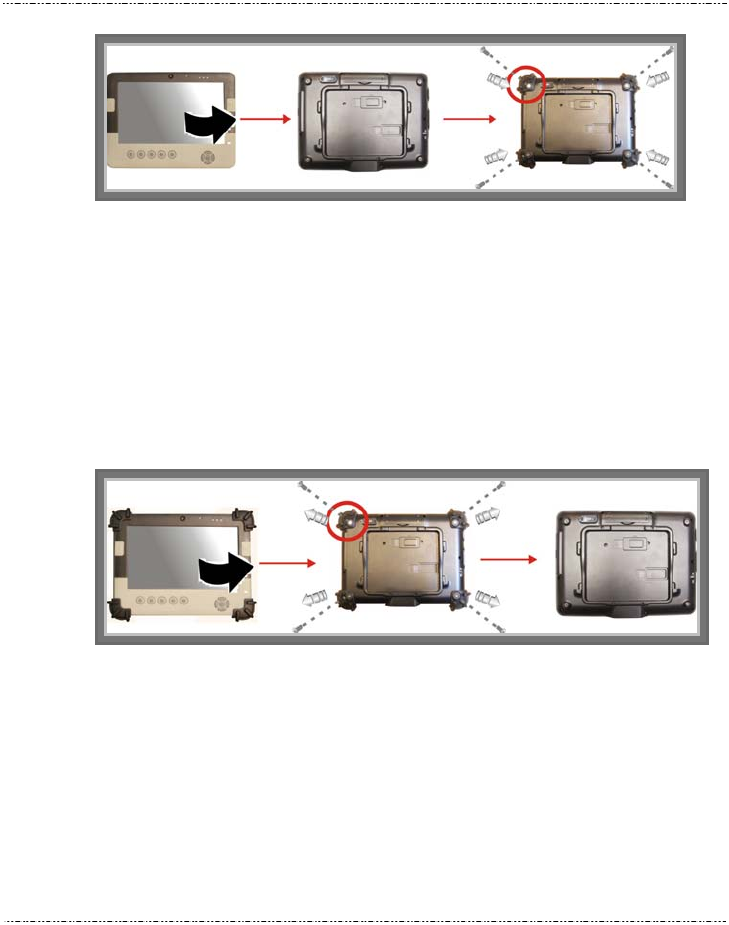
DASH
User Guide
31
1. Place the DASH to rear side and install the rubber bumpers to the 4
corners of the system.
2. Screws the rubber bumpers to fix them securely into the system.
2.2.2. Removing the Rubber Bumpers
To remove the rubber bumpers, please place the system to rear side and
unscrew the rubber bumpers of the tablet PC.
2.2.3. Plugging to the DC supply
The AC adapter provides external power source to your system and
charges the internal battery pack at the same time. The AC adapter also
has an auto-switching design that can connect to any 100VAC ~ 240VAC
power outlets.
To connect the power adapter:
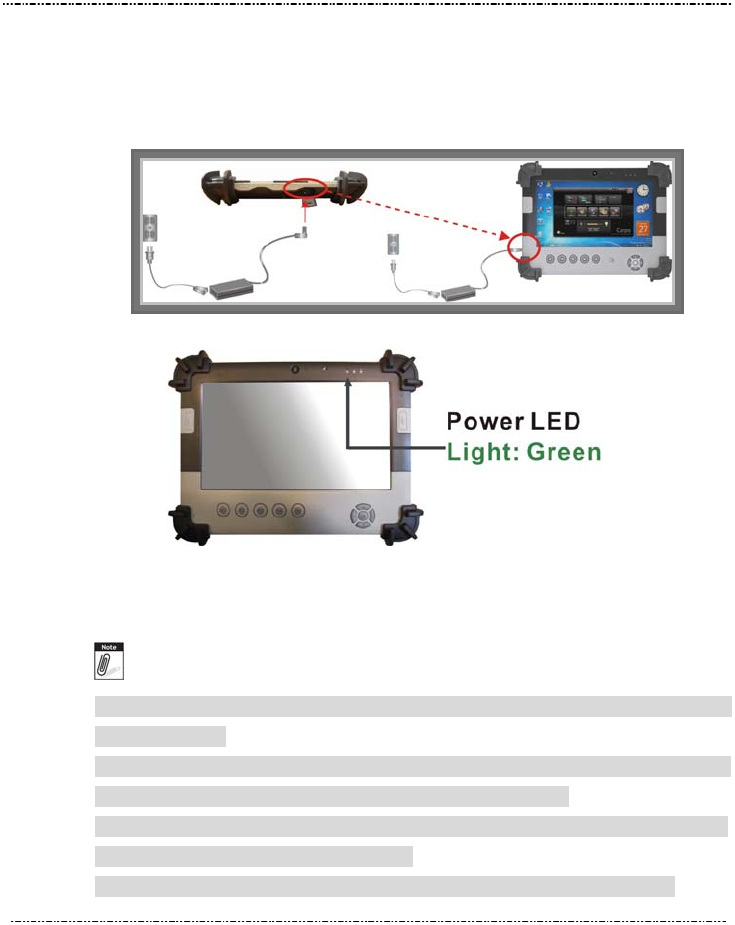
DASH User Guide
32
1. Plug the AC adapter connector to the DC-Jack socket on the left side of
the system.
2. Plug the power cord to the AC adapter.
3. Plug the other end of the power cord to a live wall outlet, at the same
time, the Power LED at face panel lights up green.
-- For the power supply of this equipment, an approved power cord has
to be used.
-- Make sure the socket and any extension cord(s) you use can support
the total current load of all the connected devices.
-- Remove all power from the device prior to installing or removing any
accessories, hardware, or cables
-- Before cleaning the system, make sure it is disconnected from
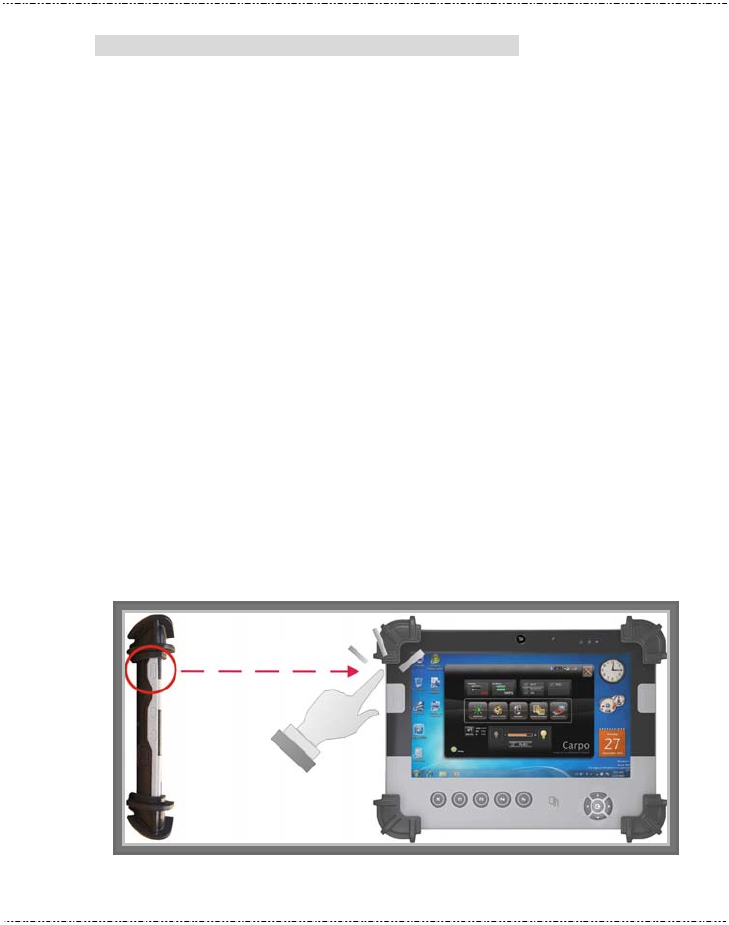
DASH
User Guide
33
any external power supplies (i.e. AC adapter).
2.2.4. Starting Your System
The Power/Resume button is found on the left side of the Tablet PC. Press
the Power/Resume button to start your system and check that if the Power
LED turns on.
After a few seconds, the system’s display will turn on and your system will
begin to execute the Power On Self Test or POST to check if all system
components are running properly. Any error found during the test will be
displayed on the screen.
After the test, the screen will also display a message "press <F2> to enter
SETUP". You don’t need to run this program at the moment as your dealer
already made the necessary settings for your computer optimal operation.
After the test has completed, your computer will start to search and boot up
the operating system from your hard drive.
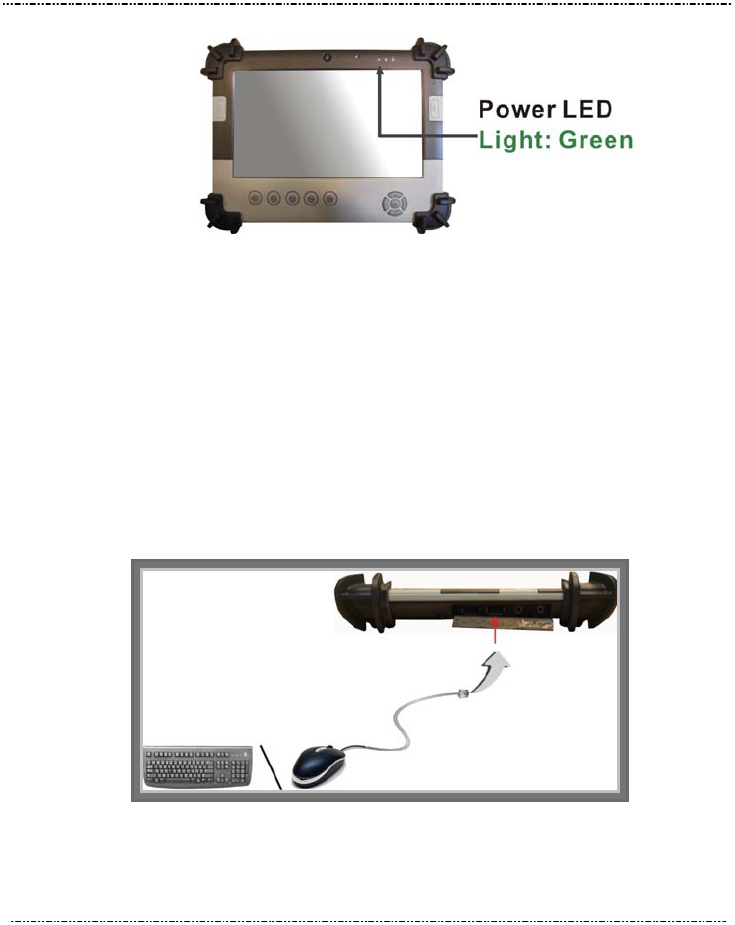
DASH User Guide
34
2.2.5. Connecting the keyboard and mouse
Before setting up the system, please make sure the following items are
available.
Keyboard
Mouse (for system software installation)
A keyboard is an input device; a mouse is a pointing device. Please connect
these two devices as graphics shown below to interact with your system.

DASH
User Guide
35
2
2.
.3
3.
.
I
In
ns
st
ta
al
ll
li
in
ng
g
t
th
he
e
D
Dr
ri
iv
ve
er
rs
s
If you already have an operating system installed into your Tablet PC, it is
best to install the needed device drivers for using the built-in devices of your
computer. Before installing the drivers, check with your dealer first if they
have already installed all the drivers along with the operating system. If not,
follow the procedures below:
Installing Windows 7 from Optical Disk Drive
To install Windows 7 directly from your optical disk drive, please go to Boot
menu of BIOS setup menu. Use arrow key to select "DVD/CD-ROM Drive",
then use "+" or "-" to move it to the top. Go to Exit menu and select "Exit
Saving Changes". Accordingly, insert the Windows 7 installation DVD into
optical disk drive with following the instructions on the screen to finish the
installation.
Driver Installation Note:
-- Please be notified that whenever you install the driver utility, it
should be installed the CHIPSET Driver first.
-- Before install Hotkey utility, please install Hotkey driver first.
-- Please install camera utility after install Hotkey utility.
-- Please install Hotkey driver and Utility first then enable
wireless devices before installing wireless devices..
Installing the Chipset Driver
Your system uses the advanced chipset. Installing the driver to enhance the
stability and performance.
Installing Chipset device driver for Window 7 x86
1. Click the Start button, then point to Run. The Run dialog box appears.

DASH User Guide
36
2. Click the Browse button and double click the directory as.
"E:\Win7/Chipset\Setup.exe".
3. When computer appears User Account Control window, click "Yes"
for accessing the computer.
4. Click "Next" continuously to install this driver when screen displays this
command.
5. Click "Yes" to accept the License Agreement.
6. Click "Next" to continue the following step.
7. Click "Next" to complete it.
8. Tick the option "Yes, I want to restart this computer now.",
and press "Finish" to restart your system.
Installing the VGA Device Driver
Following is the procedure for installing the Intel Video Accelerator 3D
Adapter VGA driver to your computer:
Installing Intel VGA device driver for Windows 7 x86
1. Click the Start button, then point to Run. The Run dialog box appears.
2. Click the Browse button and specify the directory as.
"E:\Win7/VGA\Setup.exe".
3. When computer appears User Account Control window, click "Yes"
for accessing the computer.
4. Click "Next" to install this driver when screen displays this command.
5. Click "Yes" to accept the License Agreement.
6. Click "Next" to continue the following step.
7. Click "Next" to complete it.
8. Tick the option "Yes, I want to restart this computer now.", and
press "Finish" to restart your system.

DASH
User Guide
37
Installing the Audio Device Driver
Your system uses the Realtek Audio codec.
Installing Audio device driver for Windows 7 x86
1. Click the Start button, then point to Run. The Run dialog box appears.
2. Click the Browse button and specify the directory as.
"E:\Win7/Audio\Setup.exe"
where the audio driver is located.
3. When system appears User Account Control window, click "Yes" for
accessing the computer.
4. Click "Next" to continue the following steps.
5. Tick the option "Yes, I want to restart my computer now.", and press
"Finish" to restart your system.
Installing the Touch Panel Driver
Please follow the procedures below for installing the eGalax Touch Panel
driver:
Installing Touch Panel driver for Windows 7 x86
1. Click the Start button, then point to Run. The Run dialog box appears.
2. Click the Browse button and specify the directory as.
"E:\Win7/Touch Panel\setup.exe".
3. When system appears User Account Control window, click "Yes" for
accessing the computer.
4. Click "Next" continuously to install this driver when screen displays this
command.
5. Click "OK" to continue the following step.

DASH User Guide
38
6. Un-tick item “Support Mutli-Monitor System”, and press "Next" to
continue the following step.
7. Click "Next" twice.
8. Click “Yes” to do 4 point calibration.
9. Follow the screen guide to do 4 point calibration.
Installing the LAN Device Driver
Please follow the procedures below for installing the ASIX LAN driver:
Installing LAN driver for Windows 7 x86
1. Click the Start button, then point to Run. The Run dialog box appears.
2. Click the Browse button and specify the directory as.
"E:\Win7/LAN\setup.exe".
3. When system appears User Account Control window, click "Yes" for
accessing the computer.
4. Click "Finish" to complete the installation.
Installing Hotkey Driver and Utility
Please follow the procedures below for installing the Hotkey driver and
Utility:
Installing Hotkey driver for Windows 7 x86
1. Click the Start button, then point to Run. The Run dialog box appears.
2. Click the Browse button and specify the directory as.
"E:\Win7\Hotkey\Driver\Setup.exe"
3. When computer appears User Account Control window, click "Yes"
for processing the further step.
4. Click "Next" to continue the following steps.

DASH
User Guide
39
5. Choose item "Install this driver software anyway" continuously.
6. Click "Finish" to complete it.
Installing Hotkey utility for Windows 7 x86
1. Click the Start button, then point to Run. The Run dialog box appears.
2. Click the Browse button and specify the directory as.
"E:\Win7\Hotkey\Utility\Setup.exe"
3. When computer appears User Account Control window, click "Yes"
for accessing the computer.
4. Click "Next" to continue the following steps.
5. Click "Install" to implement setup program to install the utility.
6. Tick the option "Yes, restart the computer now.", and press "Finish"
to restart your system.
Installing Wireless LAN Device Driver
Please follow the procedures below for installing the AW-NU162H or
RTL8188CE-VAU Wireless LAN Adapter driver:
Installing Wireless LAN device driver for Windows 7 x86
1. Click the Start button, then point to Run. The Run dialog box appears.
2. Click Browse button and specify the directory as
"E:\Win7\WLAN\AW-NU162H\Setup.exe" or
"E:\Win7\WLAN\RTL8188CE-VAU\Setup.exe".
3. When computer appears User Account Control window, click "Yes"
for accessing the computer.
4. Click "Next" to continue the following steps.
5. Tick the option "Yes, I want to restart my computer now.", and press
"Finish" to restart your system.

DASH User Guide
40
Installing the Bluetooth Driver and Utility
Please follow the procedures below for installing the AzureWave Bluetooth
driver:
Installing Bluetooth driver for Windows 7 x86
1. Click the Start button, then point to Run. The Run dialog box appears.
2. Click the Browse button and specify the directory as
"E:\Win7\Bluetooth\Setup.exe".
3. When screen appears the User Account Control window, click "Yes"
for processing the further step.
4. Click "Next" to continue the following steps.
5. Choose "I accept the terms in the license agreement" and click
"Next".
6. Click "Next" to continue the following steps.
7. Click "Install" to implement setup program to install this driver.
8. Click "Finish" to complete it.
Installing the Camera Utility
Please follow the procedures below for installing the Camera Utility.
Installing Bison Camera Utility for Windows 7 x86
1. Click the Start button, then point to Run. The Run dialog box appears.
2. Click the Browse button and specify the directory as.
"E:\Win7\Camera Utility\Bison\setup.exe".
3. When computer appears User Account Control window, click "Yes"
for accessing the computer.
4. Choose Setup Language and then click "Next" to continue the
following steps.
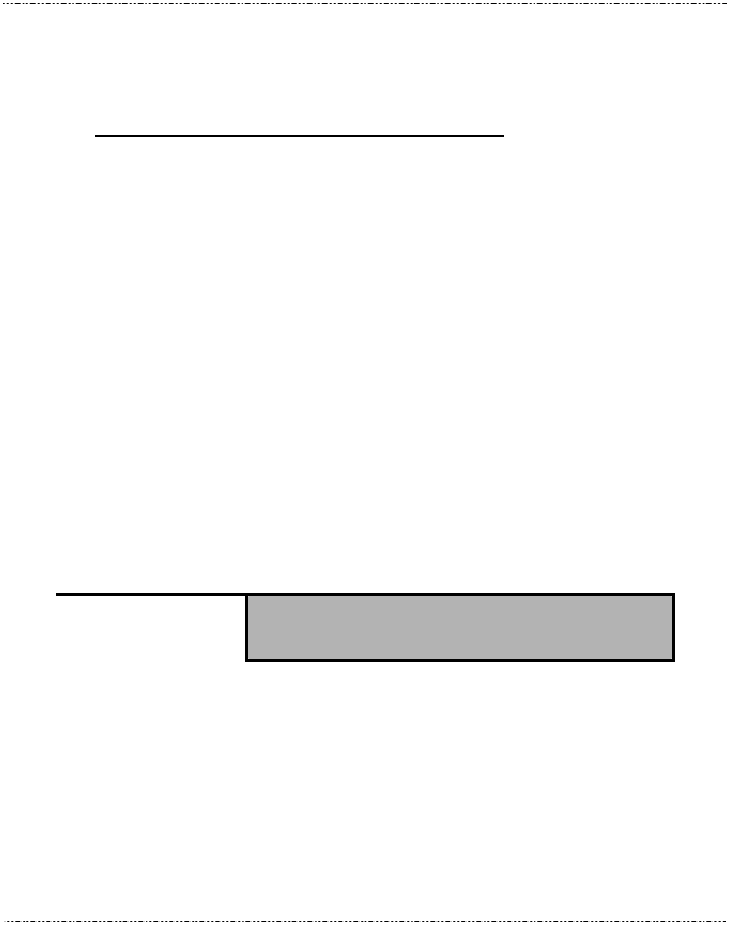
DASH
User Guide
41
5. Click "Next" again to continue the following steps.
6. Click "Finish" to complete it.
Installing Camera Utility for Windows 7 x86
1. Click the Start button, then point to Run. The Run dialog box appears.
2. Click the Browse button and specify the directory as
"E:\Win7\Camera Utility\AzureWave\setup.exe" and
"E:\Win7\Camera Utility\Bison\setup.exe"\
3. When computer appears User Account Control window, click "Yes"
for accessing the computer.
4. Choose Setup Language and then click “OK” to continue the following
steps.
5. Click "Next" twice to continue the following steps.
6. Click "Install" to begin the installation.
7. Click "Finish" to complete it.
C
Ch
ha
ap
pt
te
er
r
3
3
Using the DASH
3
3.
.1
1.
.
I
In
nt
tr
ro
od
du
uc
ct
ti
io
on
n
This chapter describes the basic features and procedures for using the
panel PC. It includes the I/O ports connecting and the touch screen
operation.
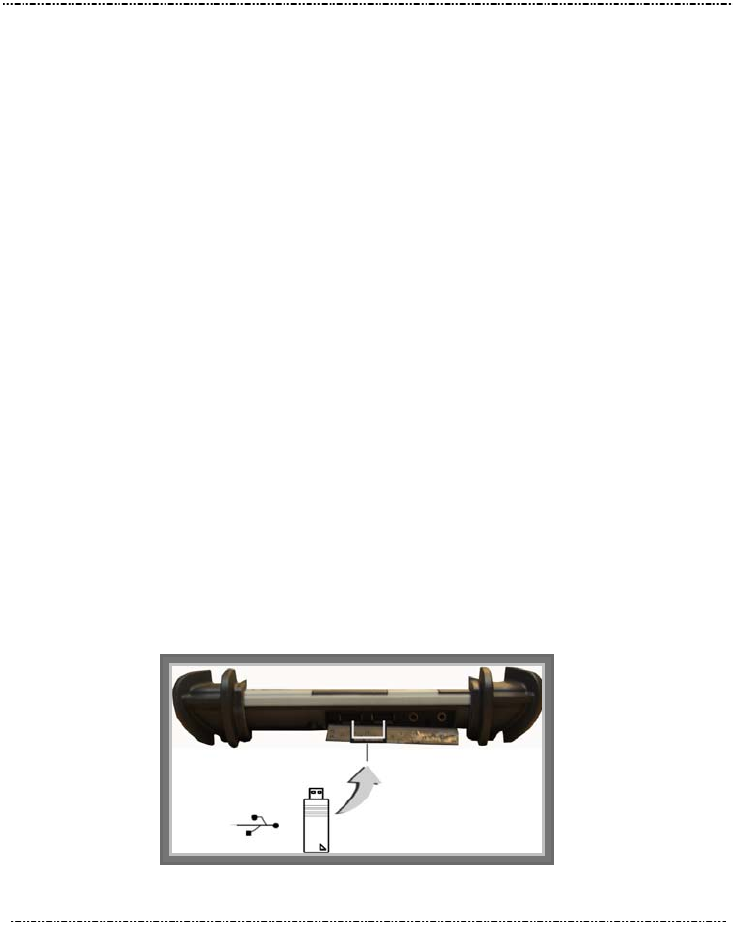
DASH User Guide
42
3
3.
.2
2.
.
U
Us
si
in
ng
g
t
th
he
e
U
US
SB
B
P
Po
or
rt
ts
s
USB (Universal Serial Bus) is a hardware interface that enables you to
connect multiple devices (such as printers, mice, keyboards, storage
devices, joysticks, digital cameras, and video conference cameras, etc.) to
your tablet pc and up to 127 devices can be attached. Besides, USB’s hot
swap capability allows everything to be plugged in and unplugged without
turning the system off.
Microsoft, HP, Compaq, Intel, Agere, NEC and Philip are seven core
members of USB-IF to have worked on USB 2.0 standardization. USB 2.0
offers data transfer rate up to 480Mbps (megabits per second) compared to
USB 1.1 devices, which transfer at speeds of 12Mbps. So, you could know
that USB 2.0 can transfer data between the computer and its peripherals 40
times faster than USB 1.1. However, USB 2.0 is fully backward compatible,
you will be able to use a USB 1.1 device in a USB 2.0 compliant system.
1. Connect the external device to the system.
2. The USB ports support hot plug-in connections. Install the device driver
before using the device.
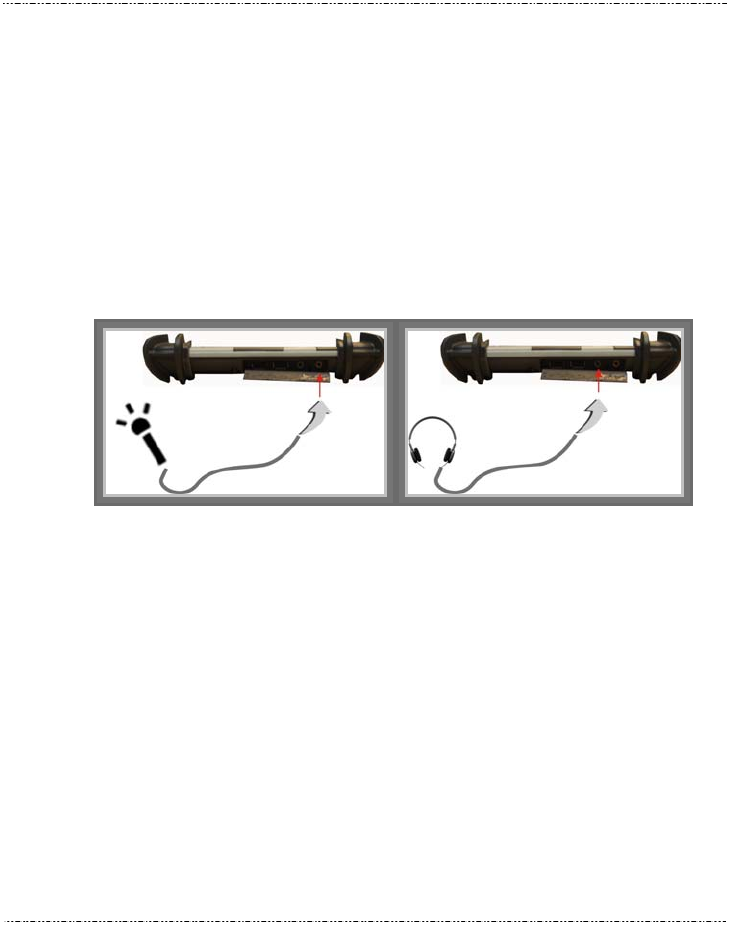
DASH
User Guide
43
3
3.
.3
3.
.
U
Us
si
in
ng
g
t
th
he
e
E
Ex
xt
te
er
rn
na
al
l
A
Au
ud
di
io
o
S
Sy
ys
st
te
em
m
At the right side of your Tablet PC, you will find the built-in audio ports for
connecting Microphone jacks, earphone or powered speaker.
To connect to an audio jack:
1. Locate the audio ports (Microphone and Headphone) that you want to
use to the target device.
2. Plug the jack into the port on the right side of the system.
3
3.
.4
4.
.
I
In
ns
st
ta
al
ll
li
in
ng
g
t
th
he
e
B
Ba
at
tt
te
er
ry
y
DASH provides optional external battery to extend the power of your
system.
For installing the battery pack, please follow the steps below:
1. Turn off the system.
2. Align the hook wall at the rear side, then place and screw it fixedly.
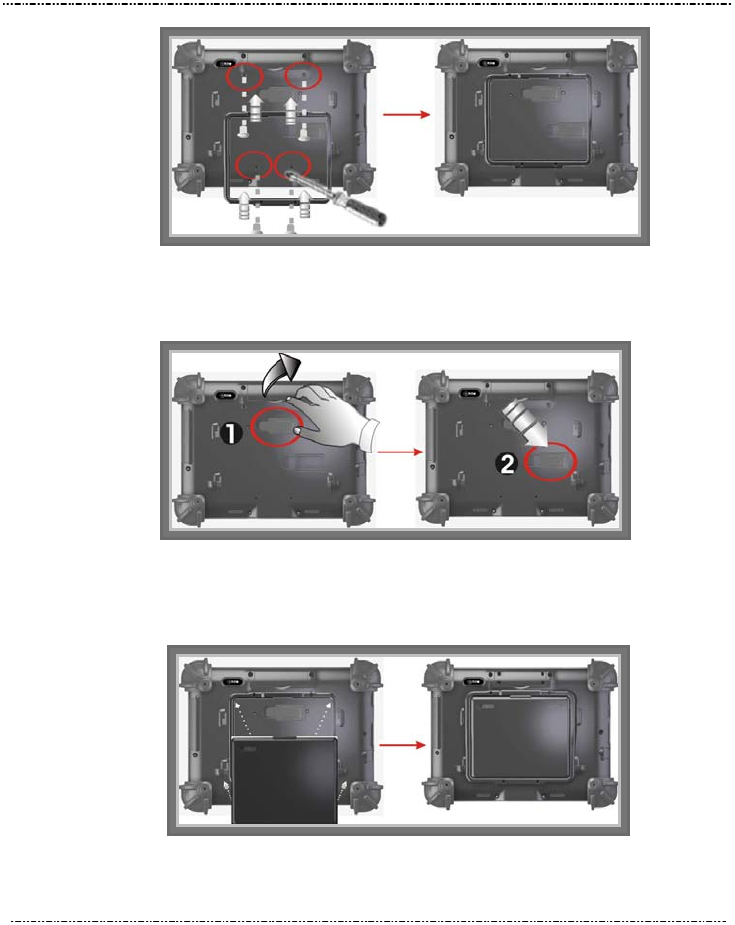
DASH User Guide
44
3. Remove the cover of the external battery connector (as marked
below) and place it on the lower position (as marked below).
4. Snap the battery pack into the external battery connector and hook
into the hook wall securely.
For removing the external battery, repeat the above steps in reverse order
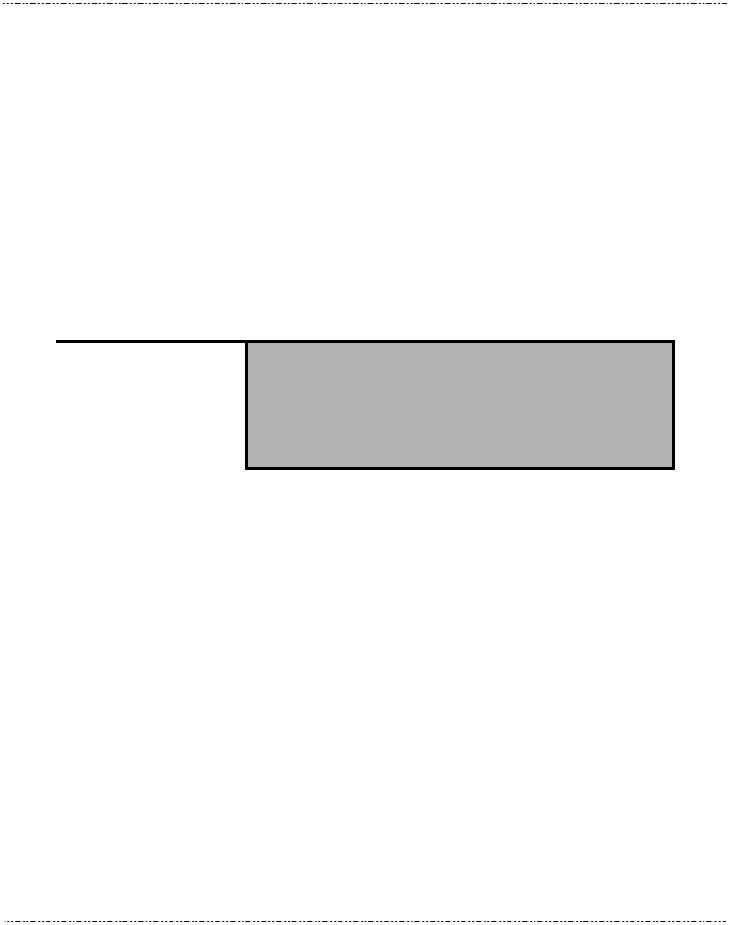
DASH
User Guide
45
to remove the battery.
C
Ch
ha
ap
pt
te
er
r
4
4
The BIOS Setup
Program
This system comes with a chip from Phoenix BIOS that contains the ROM
Setup information for your system. (This chip serves as an interface between
the processor and the rest of the system components.) This section explains
the information contained in the Setup program and tells you how to modify the
settings according to your system configuration.
The Setup utility program allows updates to the main board configuration
settings. The BIOS setup values will be saved in the CMOS. It is executed
when you change the system configuration, you change the system backup
battery, or the system detects a configuration error and asks you to run the
Setup program. You must have connected a USB type of keyboard, and Use
the arrow keys to select, and press Enter to run the selected program.
Function Key
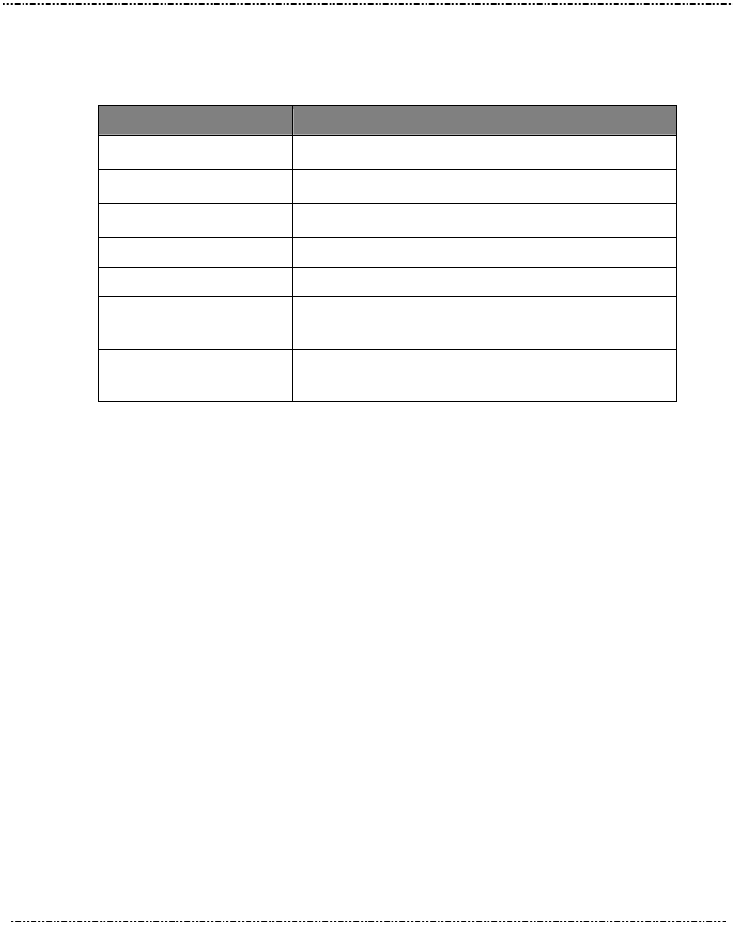
DASH User Guide
46
Please check the following table for the function description of each direction
key.
Function Key (s) Function Description
Moves cursor left to select Screens
/ Moves cursor up or down to select items
+ / - To change option for the selected items
<Tab> To bring up the selected screen
<F1> To display the General Help screen
<F10> To save changes and exit the BIOS
SETUP UTILITY
<ESC> To jump to the Exit Screen or exit the
current screen
4
4.
.1
1.
.
M
Ma
ai
in
n
S
Sc
cr
re
ee
en
n
S
Se
et
tu
up
p
U
Ut
ti
il
li
it
ty
y
When you enter the BIOS SETUP UTILITY, the Main screen will appear and
display the system overview.
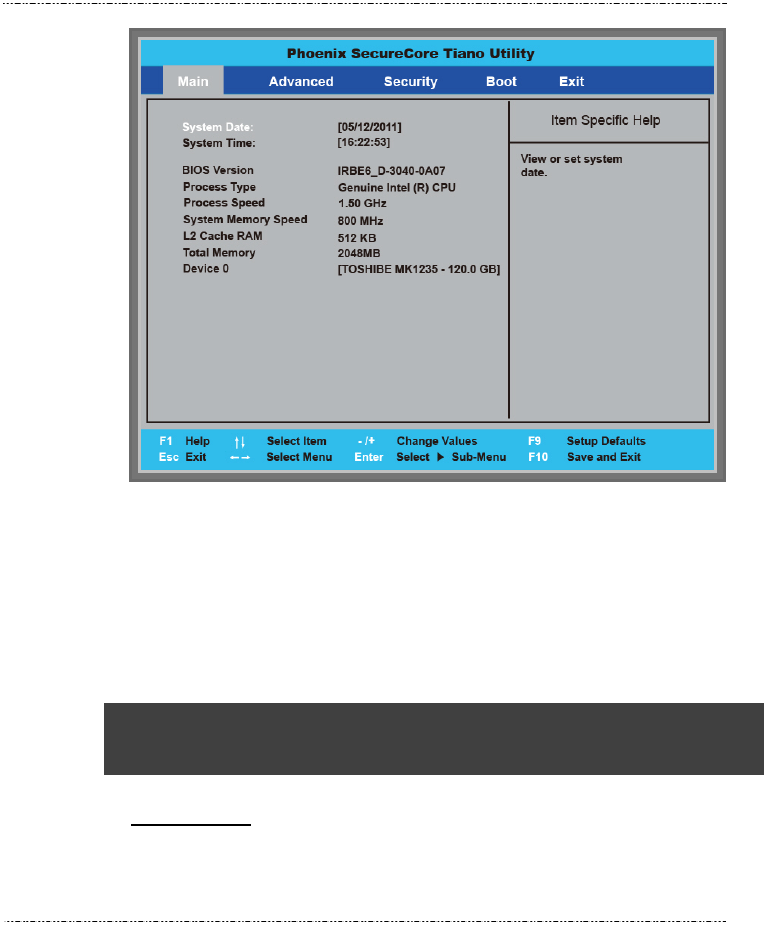
DASH
User Guide
47
The Standard CMOS Setup screen is displayed above. Each feature may
have one or more option settings. Use the arrow keys to highlight the
feature you want to change and then use “”or “” to select the value you
want for that feature.
NOTE: The system BIOS automatically detects AMIBIOS, Processor,
memory size, thus no changes are necessary.
NOTE: The system BIOS automatically detects Phoenix, Processor,
memory size, thus no changes are necessary.
System Date
To set the date, highlight the Date field and then press +/- keys to set
the current date. Follow the month, day and year format.
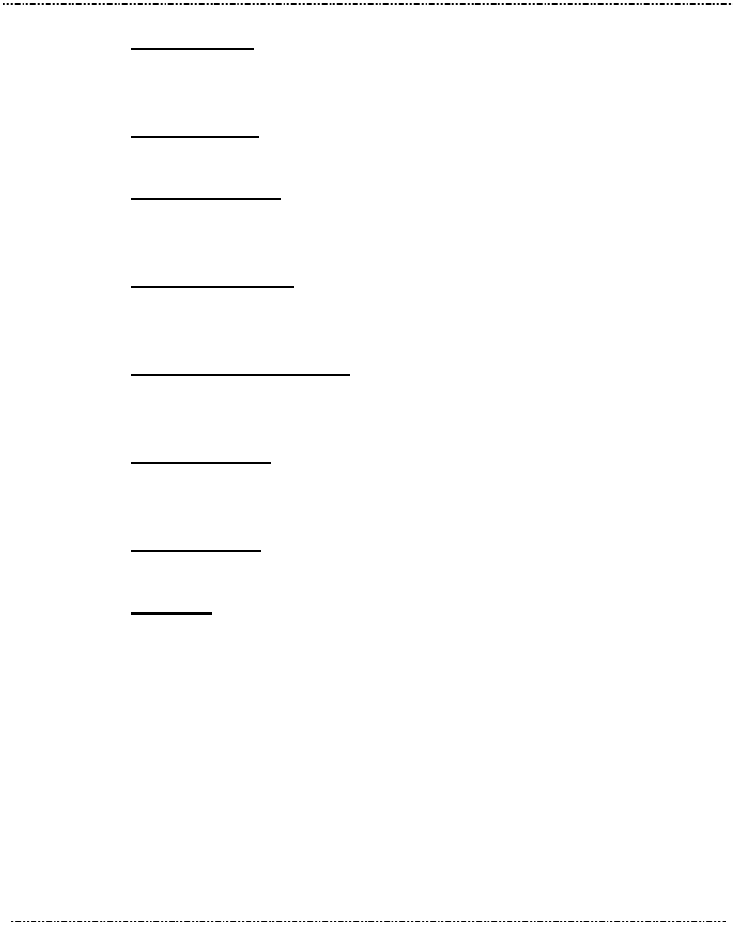
DASH User Guide
48
System Time
To set the time, highlight the Time field and then press +/- keys to set
the current time. Follow the hour, minute, and second format.
BIOS Version
The system will automatically displays the information of BIOS version.
Processor Type
The system will automatically displays the information of Processor
Type.
Processor Speed
The system will automatically displays the information of Processor
Speed.
System Memory Speed
The system will automatically displays the information of System
Memory Speed.
L2 Cache RAM
The system will automatically displays the information of L2 Cache
RAM.
Total Memory
The system will automatically displays the information of Total Memory.
Device 0
The system will automatically displays the information of Device 0.
4
4.
.2
2.
.
A
Ad
dv
va
an
nc
ce
ed
d
B
BI
IO
OS
S
F
Fe
ea
at
tu
ur
re
es
s
For Advanced Settings, the BIOS will automatically display the Platform
information and let you define the configuration when system booting.
In this section, you may set the configurations for the following items: Quick
boot, UEFI boot, Legacy boot, and Boot Priority.

DASH
User Guide
49
Quick Boot
Lets you activate or close the Quick boot function by selecting Enabled
or Disabled option.
UEFI Boot
Lets you activate or close the UEFI boot function by selecting Enabled
or Disabled option.
Legacy Boot
Lets you activate or close the Legacy boot function by selecting
Enabled or Disabled option.
Boot Priority
Lets you set the boot priority from UEFI boot or HDD boot.
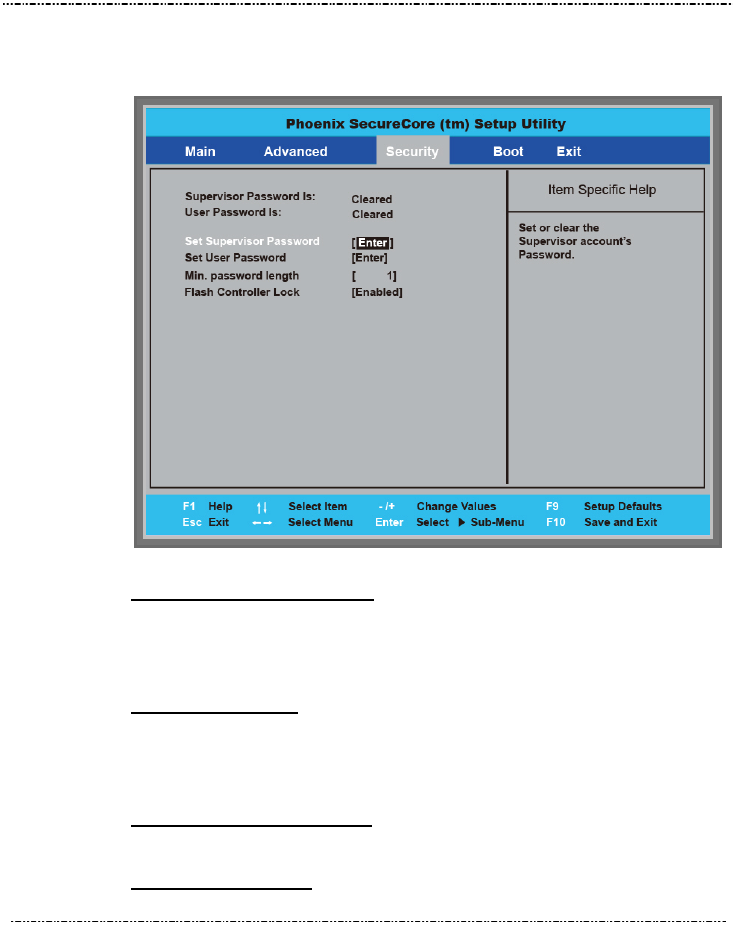
DASH User Guide
50
4
4.
.3
3.
.
S
Se
ec
cu
ur
ri
it
ty
y
C
Ch
hi
ip
p
C
Co
on
nf
fi
ig
gu
ur
ra
at
ti
io
on
n
Supervisor Password is:
This option displays the status of Supervisor Password. If the password
is entered, it will display “Set” information, or it will display “Cleared”
information when there is no password setting.
User Password is
This option displays the status of User Password. If the password is
entered, it will display “Set” information, or it will display “Cleared”
information when there is no password setting.
Set Supervisor Password
This field let you set or clear the Supervisor account’s password.
Set User Password
This field let you set or clear the User account’s password.
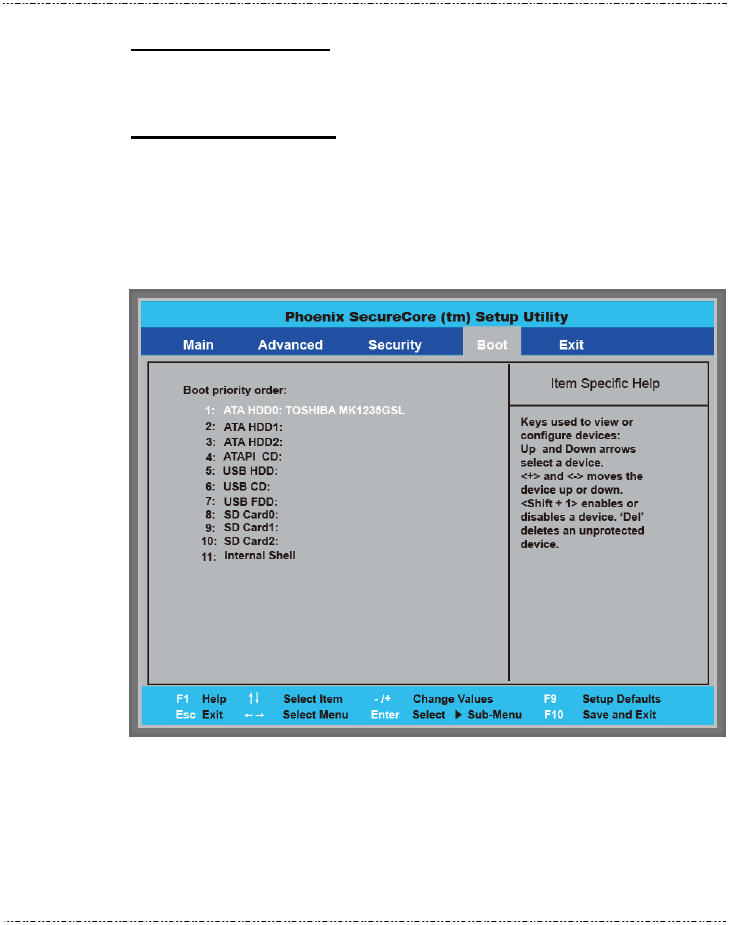
DASH
User Guide
51
Min password length
Lets you set the minimum number of characters for password. The
value is from 1 to 20.
Flash Controller Lock
Lets you lock or unlock flash controllers by selecting “Enabled” or
“Disabled” option.
4
4.
.4
4.
.
B
Bo
oo
ot
t
M
Ma
an
na
ag
ge
em
me
en
nt
t
S
Se
et
tu
up
p
This page allows you to set the search drive sequence where the system
will try to boot up first.
To select the boot device, you can use the up or down arrow key, then press
<+> to move up the device in the list or press <-> to move down the device
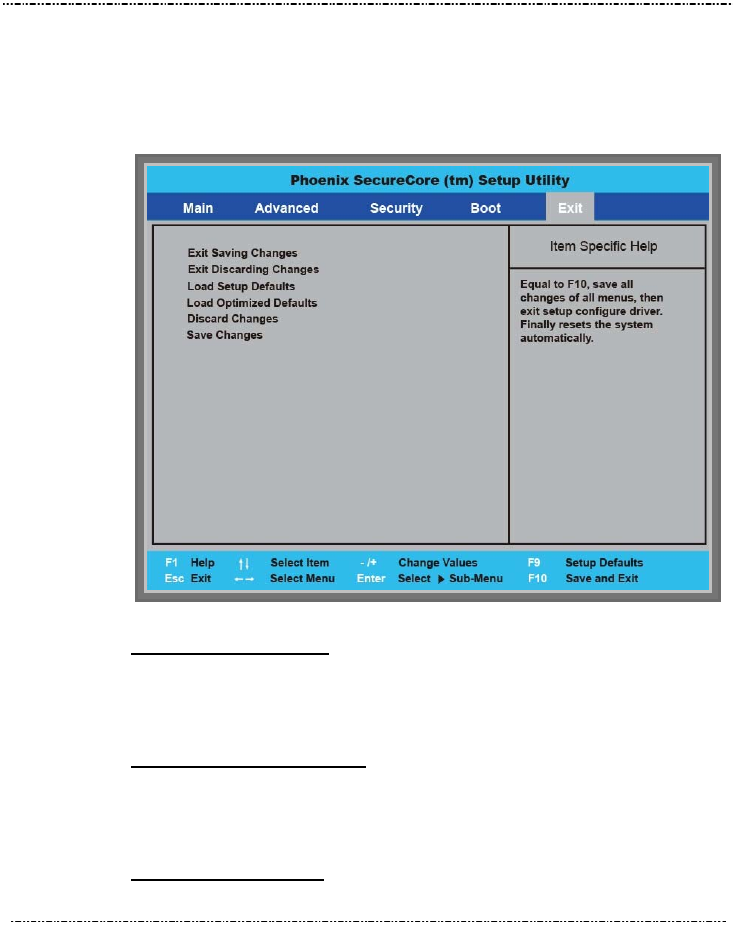
DASH User Guide
52
in the list. To exit from this menu, press <Esc>.
4
4.
.5
5.
.
E
Ex
xi
it
t
C
Co
on
nt
tr
ro
ol
l
Exit Saving Changes
When you select this option, it will pop-out the following message,
“Save configuration changes and exit setup?” Select [OK] to save the
changes and exit the BIOS SETUP UTILITY.
Exit Discarding Changes
When you select this option, it will pop-out the following message,
“Discard changes and exit setup?”. Select [OK] to exit the BIOS SETUP
UTILITY without saving any changes.
Load Setup Defaults
When you select this option, it will pop-out the following message,

DASH
User Guide
53
“Load optimal defaults?” Select [OK] to load the default values for all
the setup configurations.
Load Optimized Defaults
When you select this option, it will pop-out the following message,
“Load optimal defaults?” Select [OK] to load the default values for all
the setup configurations.
Discard Changes
When you select this option, it will pop-out the following message,
“Discard changes?” Select [OK] to discard all changes.
Save Changes
When you select this option, it will pop-out the following message,
“Save changes?” Select [OK] to save all changes.
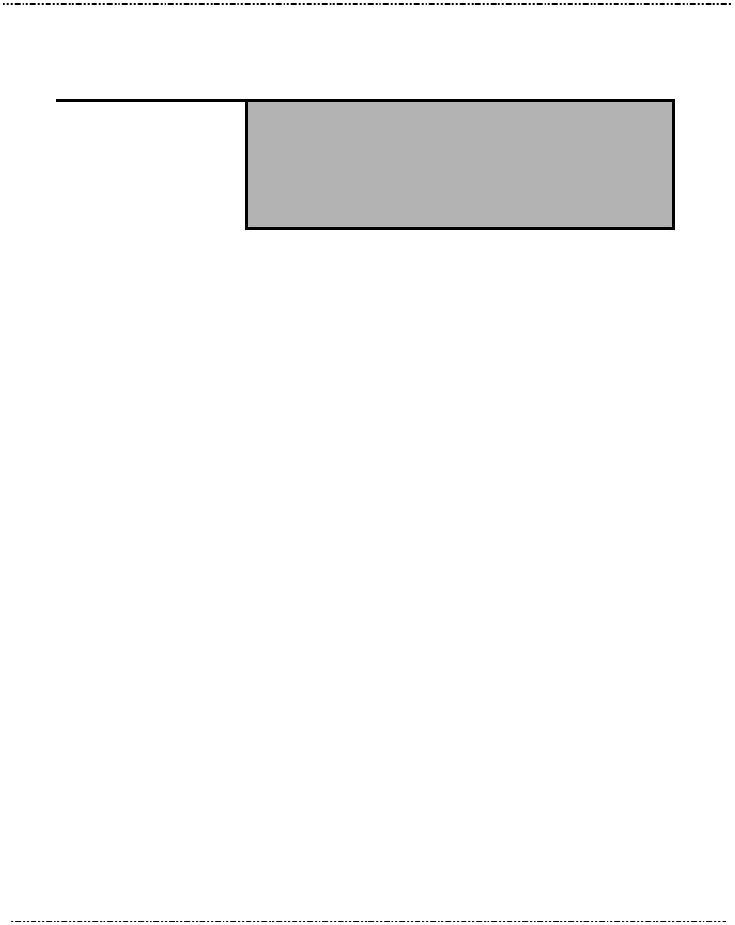
DASH User Guide
54
C
Ch
ha
ap
pt
te
er
r
5
5
User Interface for
DASH
5
5.
.1
1.
.
I
In
nt
tr
ro
od
du
uc
ct
ti
io
on
n
This user interface provides specific mobile utility to let you easily setup
some helpful functions and aware the system status directly.
This utility also let you adjust some function to fit the requirements, such as
brightness and volume adjustment, webcam launch, screen orientation and
monitor switching.
Furthermore, it also provides system information for your reference, such
as battery status, RF setting with its signal strength, firmware (BIOS & EC)
version information. Besides these features, you can press the soft button
to hibernate this device.
5
5.
.2
2.
.
A
Ab
bo
ou
ut
t
t
th
he
e
U
Us
se
er
r
I
In
nt
te
er
rf
fa
ac
ce
e
5.2.1 Enable or disable the User Interface
To display the User Interface, please press the Fn button or point the Hot
key Utility on the screen.
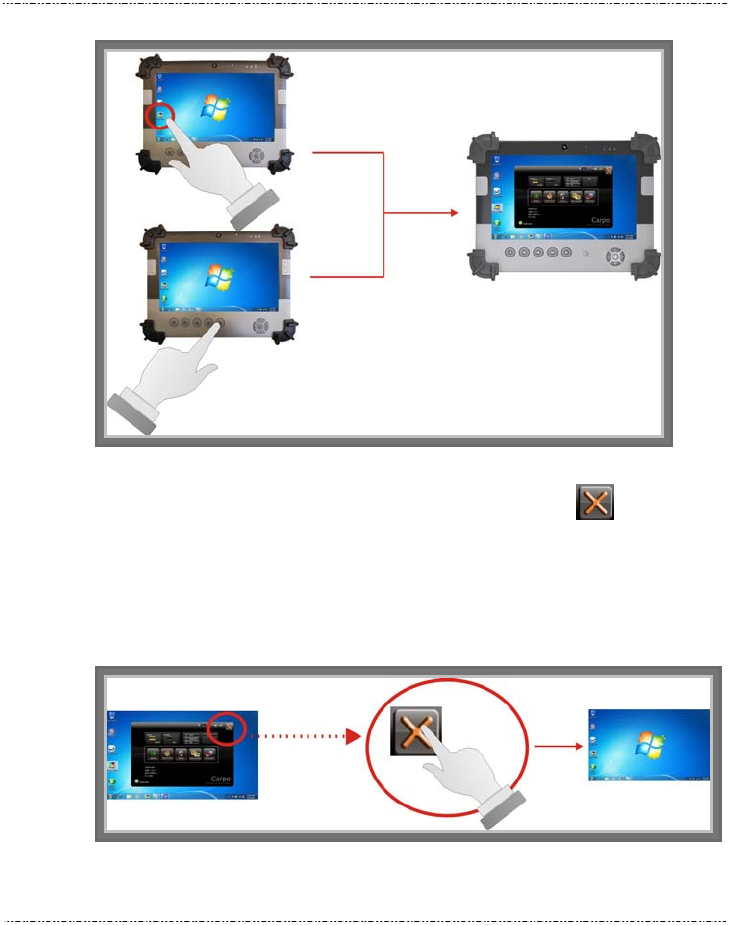
DASH
User Guide
55
To close the User Interface function, please press the button on the
top right corner on this User Interface for disabling this utility from the
screen.
If there is no action took for this utility in 5 seconds, the UI screen will close
automatically.
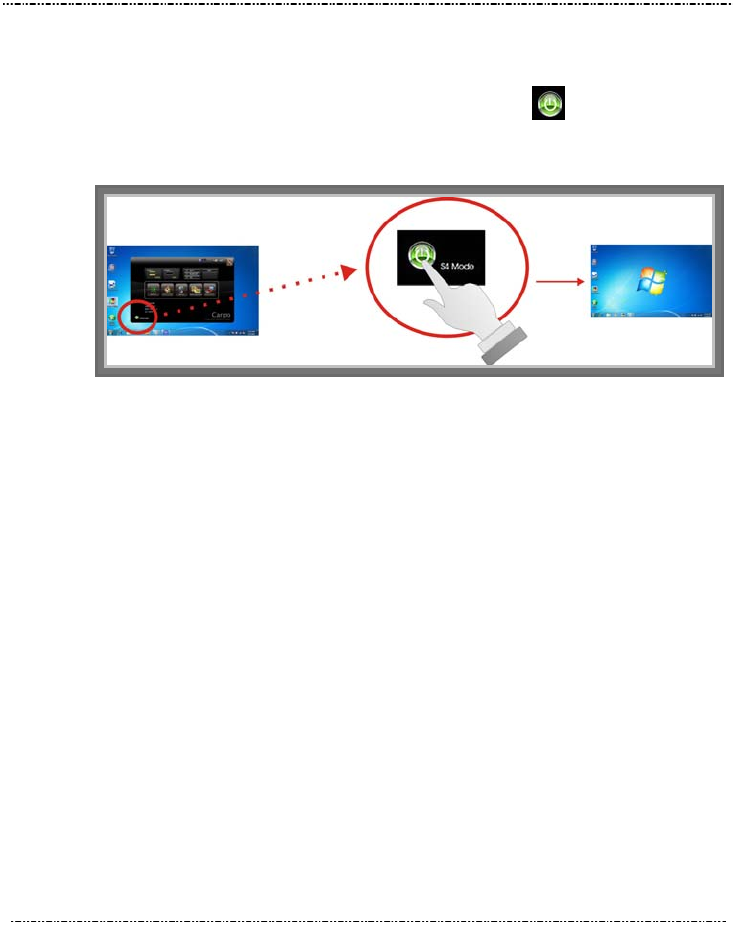
DASH User Guide
56
5.2.2 Hibernate this System
If you want to hibernate this system, please click button for entering
into S4 mode.
5.2.3 System Status Information
This utility shows you the battery capacity status, RF status with its signal
strength and system information, and provides the control panel for the
function setting.

DASH
User Guide
57
For battery capacity status:
The
DASH is equipped with one internal battery and one optional battery.
The battery capacity status shown below advises you, that only one internal
battery is embedded with the system with fully charged, and there is no
optional battery installed in the system.
If the system installs both the 1st internal battery and 2nd optional battery,
the graphics shown below indicates the charging status.
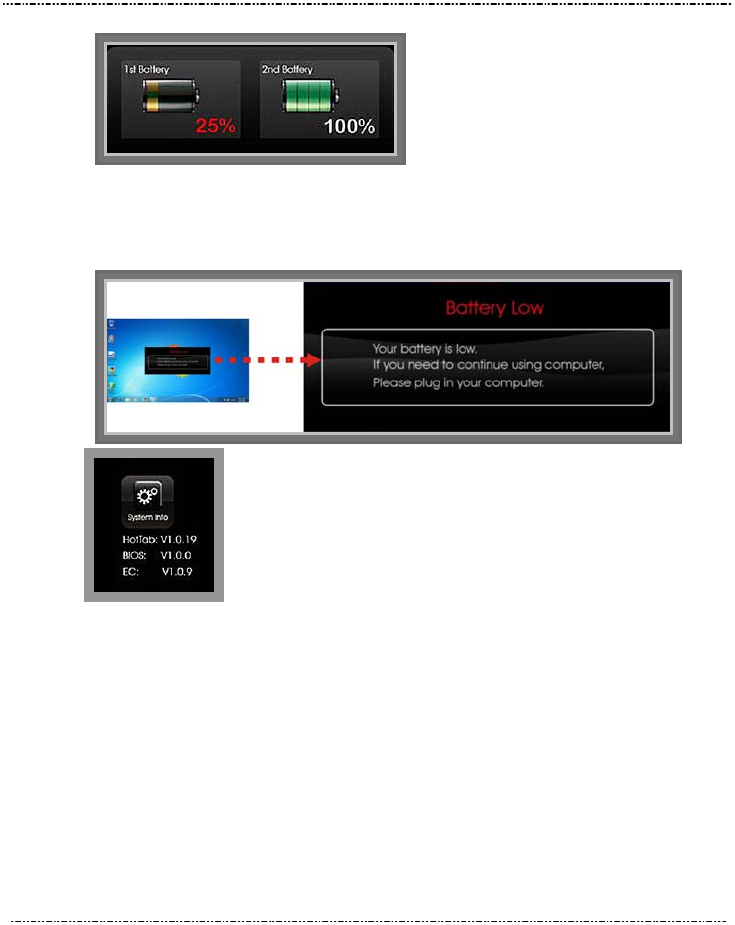
DASH User Guide
58
If 1st battery capacity is down to 15%, the system will display the following
warning message for 5 seconds
For System Information:
The system information shown on the left advises you
the utility version, BIOS and EC version and you can use
them for customer service.
5
5.
.3
3.
.
U
Us
si
in
ng
g
t
th
he
e
A
Ap
pp
pl
li
ic
ca
at
ti
io
on
n
Your DASH has numbers of applications on the control panel for executing
specific command. It provides you to adjust brightness, volume, launch
webcam, make screen orientation and switch monitor.
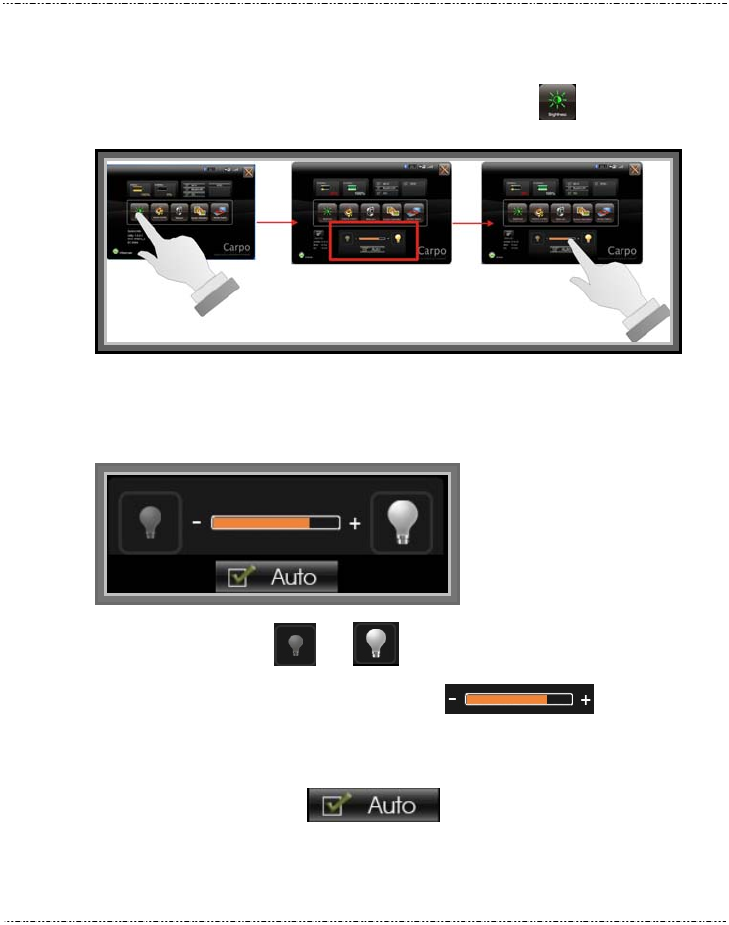
DASH
User Guide
59
5.3.1 Brightness Control
For brightness adjustment, press the Brightness command.
When you press it, the brightness control panel is appeared as follows:
You can click or to reduce or increase the brightness.
Also, you can slide the scale bar to set the
brightness.
Since the system supports the light sensor, if you tick the brightness
Auto adjustment , the screen brightness will
automatically adjust according to the operating environment.
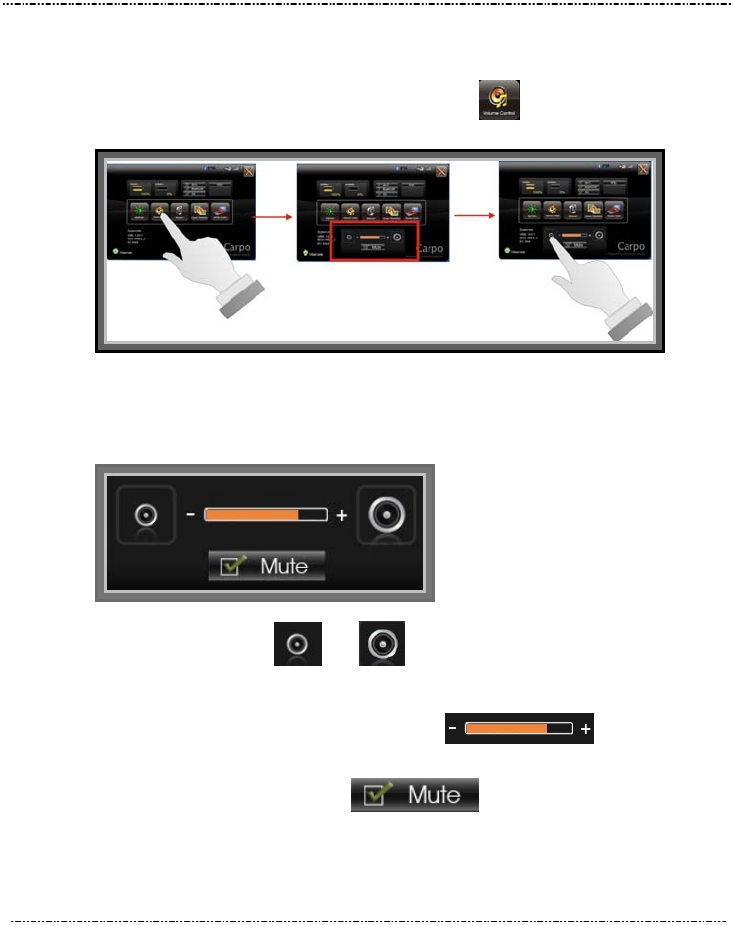
DASH User Guide
60
5.3.2 Volume Control
For Volume adjustment, press the Volume command.
When you press it, the Volume control panel is appeared as follows:
You can click or to reduce or increase the audio
volume incrementally.
Also, you can slide the scale bar to set the audio
volume.
You can tick the Mute to make the system voiceless.
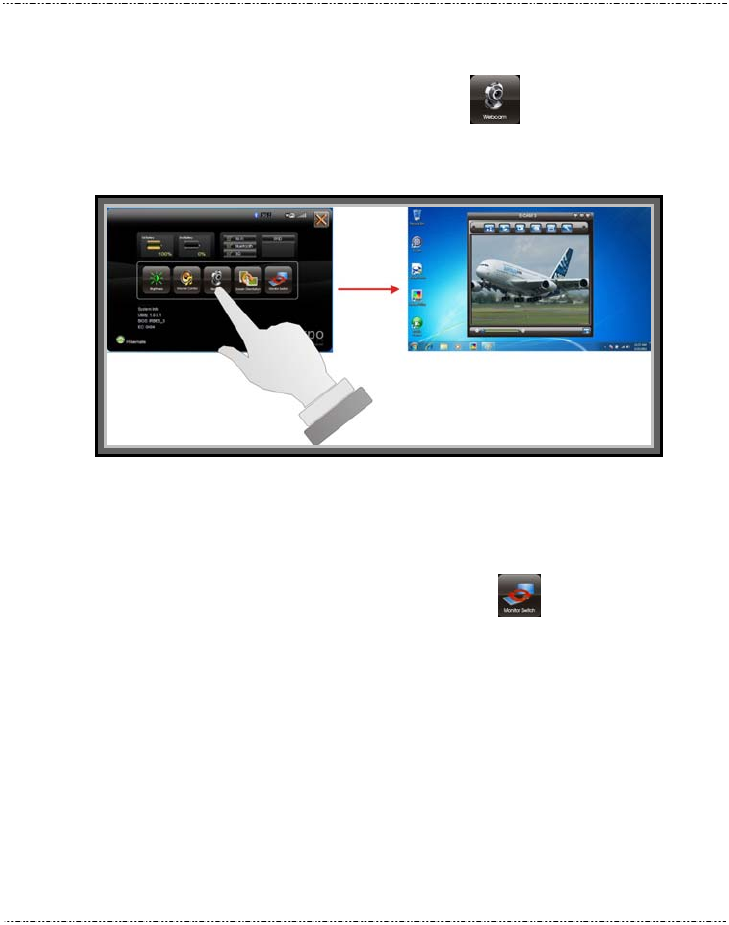
DASH
User Guide
61
5.3.3 Webcam Launch
For Webcam Launch, press the Webcam command to appear the
Webcam utility for your application.
5.3.4 Monitor Switch
For Monitor switch, press the Monitor Switch to pop-up the selection
bar for choosing the display mode within following four options.
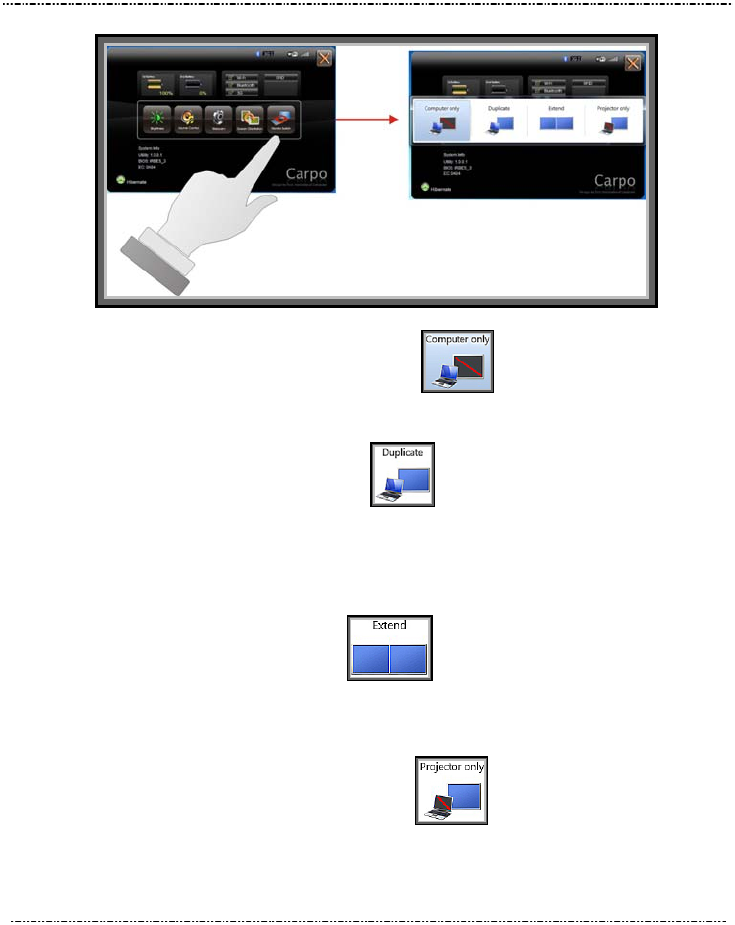
DASH User Guide
62
You can click Computer only to display the DASH screen
only.
You can click Duplicate to display the same contents both
on the DASH screen and external display device. The resolution on
these two display modes are same, it is not available to adjust the
resolution on the external display mode.
You can click Extend to display the different contents on
the DASH screen and external display device. You only can adjust
the resolution on the external display device.
You can click Projector only to display on external
projector only.

DASH
User Guide
63
C
Ch
ha
ap
pt
te
er
r
6
6
Maintenance
Your DASH needs occasional cleaning to prolong their life. Please read this
section carefully to ensure proper care of DASH. When it is necessary to
clean it, use a soft, lint-free cloth, slightly dampened with a mild detergent
solution or use the contents of any commercially available computer cleaning
kit.
Never use petroleum-based solvents, or harsh detergents to clean the system.
Also never spray any liquids directly on the computer case or screen. If the
display screen has become smeared or dusty, clean the screen by first
applying a mild glass cleaner to a soft, clean, lint-free cloth, and gently wipe
the glass. Never apply liquids directly on the screen surface. Moreover, do not
use paper towels to clean the display screen. Paper can scratch the display
screen matte.
6
6.
.1
1.
.
M
Ma
ai
in
nt
ta
ai
in
ni
in
ng
g
t
th
he
e
B
Ba
at
tt
te
er
ry
y
Do not expose heat or attempt to disassemble the battery, and do not
place the battery in water or in a fire.
Do not subject the battery to strong impact, such as a blow from a
hammer, or stepping on or dropping it.
Do not puncture or disassemble the battery.
Do not attempt to open or service the battery.
Replace only with batteries designed specifically for this product.
Keep the battery out of reach of children.

DASH User Guide
64
Dispose of used batteries according to local regulations.
6
6.
.2
2.
.
M
Ma
ai
in
nt
ta
ai
in
ni
in
ng
g
t
th
he
e
L
LC
CD
D
D
Di
is
sp
pl
la
ay
y
Do not scratch the surface of the screen with any hard objects.
Do not spray liquid directly on the screen or allow excess liquid to drip
down inside the device.
Do not place anything, such as food and drink, on the screen at any
time to prevent damage to the screen.
Clean the LCD display only with a soft cloth dampened with
denatured alcohol or a proprietary LCD screen cleaner.
6
6.
.3
3.
.
C
Cl
le
ea
an
ni
in
ng
g
t
th
he
e
D
DA
AS
SH
H
Turn off the DASH and unplug the power cord.
Wipe the screen and exterior with a soft, damp cloth moistened only
with water. Do not use liquid or aerosol cleaners on the screen, as
these will discolor the finish and damage the screen.